Analysis of the Life Cycle and Properties of Concrete with the Addition of Waste Car Glass
Abstract
1. Introduction
2. Description of the Test Method
- Portland cement, CEM I 52.5 R—SR5,
- Natural fine aggregate—sand with fraction 0–2—(K1),
- Coarse natural aggregate—basalt fraction 2–8—(K2),
- tap water,
- fluidizing admixture.
- 27 cubes with dimensions of 150 × 150 × 150 mm—six reference samples and seven samples for each modification,
- 12 cylinders with a diameter of 150 mm and a height of 300 mm—three reference samples and three samples for each modification,
- 12 pieces of beams with dimensions of 100 × 100 × 500 mm—three pieces of reference samples and three pieces of samples for each modification.
- Thermal conductivity—λ
- Thermal capacity—Cp
- Thermal diffusivity—a
- XF3—freeze/thaw attack,
- XM2—mechanical attack,
- XA2—chemical attack,
- XD2—corrosion induced by chlorides,
- XC3—corrosion induced by carbonation,
- Compressive strength: 70.13 MPa
- Flexural strength: 5.70 MPa
- Splitting tensile strength—cubic specimens: 2.82 MPa
- Splitting tensile strength—cylindrical specimens: 3.08 MPa
- Dynamic Young’s modulus: 46.9 GPa
- Static Young’s modulus: 40.4 GPa
- Thermal properties:
- Design point load—wheels—40 kN,
- Design point load—shelves—25 kN,
- 1.
- Inventory analysis—production phase
- 2.
- Inventory analysis—construction phase
- 3.
- Inventory analysis—exploitation phase
- 4.
- Inventory analysis—end-of-life phase
- Sand: approximately 72%
- Soda: approximately 13%
- Limestone: approximately 8%
- Dolomite: approximately 4%
- Alumina: approximately 1%
- Temperature variables (from −70 °C to 150 °C),
- Moisture,
- Emphasis,
- Action of bases, acids and salts,
- UV radiation,
- dirt,
- Abrasion.
- Facilitating the distribution and compaction of the concrete mix,
- Improving water and frost resistance,
- Improvement of the early and final strength of concrete.
3. Results
4. Research Significance
5. Conclusions
6. Discussion
- Ali İhsan Çelik, et al. [104]; Mechanical Behavior of Crushed Waste Glass as Replacement of Aggregates.
- 2.
- Ibrahim Almeshal, et al. [15]; Mechanical properties of eco-friendly cements-based glass powder in aggressive medium.
- 3.
- Shaker Qaidi, et al. [14]; Concrete Containing Waste Glass as an Environmentally Friendly Aggregate: A Review on Fresh and Mechanical Characteristics
- 4.
- Ali İhsan Çelik, et al. [105]; Use of waste glass powder toward more sustainable geopolymer concrete
- 5.
- Zeybek Ö., et al. [106]; Influence of Replacing Cement with Waste Glass on Mechanical Properties of Concrete
7. Recommendations
- More investigation is required into the mechanical characteristics of high-performance and high-strength waste-glass concrete.
- The effects of different types and sizes of glass particles on concrete mixes should be thoroughly researched in the future.
- Test fewer common types of glass as aggregates in concrete because the vast majority of research only covers soda-lime, borosilicate or lead glass.
- Conduct a comprehensive evaluation of the real environmental effects through a thorough and detailed life-cycle assessment to evaluate the feasibility of using this waste.
8. Further Research
- confirmation of the origin of the glass, as its chemical composition may significantly change the physicochemical properties of the finished composites.
- considering adding more glass in favor of a weaker type of cement, e.g., metallurgical, to reduce the CO2 footprint.
- the possibility of using glass aggregate as a substitute for all natural aggregate used in the production of concrete composite.
- the possibility of using chemical additives to modify the physical properties of composites, e.g., increasing the strength between cement and glass aggregate or accelerating or slowing down the hydration reaction.
Author Contributions
Funding
Institutional Review Board Statement
Informed Consent Statement
Data Availability Statement
Acknowledgments
Conflicts of Interest
References
- Tan, K.H.; Du, H. Use of waste glass as sand in mortar: Part I—Fresh, mechanical and durability properties. Cem. Concr. Compos. 2013, 35, 109–117. [Google Scholar] [CrossRef]
- EPA. United States Environmental Protection Agency, Advancing Sustainable Materials Management: 2017 Fact Sheet, EPA. United States Environmental Protection Agency. 2017. Available online: https://www.epa.gov/sites/production/files/2019-11/documents/2017_facts_and_figures_fact_sheet_final.pdf (accessed on 24 May 2023).
- LCQ9. Recovery and Recycling of Waste Glass. 2020. Available online: https://www.info.gov.hk/gia/general/202001/08/P2020010800455p.htm (accessed on 24 May 2023).
- Bostanci, S.C.; Limbachiya, M.; Kew, H. Portland-composite and composite cement concretes made with coarse recycled and recycled glass sand aggregates: Engineering and durability properties. Constr. Build. Mater. 2016, 128, 324–340. [Google Scholar] [CrossRef]
- Guo, P.; Meng, W.; Nassif, H.; Gou, H.; Bao, Y. New perspectives on recycling waste glass in manufacturing concrete for sustainable civil infrastructure. Constr. Build. Mater. 2020, 257, 119579. [Google Scholar] [CrossRef]
- Mohammadhosseini, H.; Tahir, M.M. Durability performance of concrete incorporating waste metalized plastic fibres and palm oil fuel ash. Constr. Build. Mater. 2018, 180, 92–102. [Google Scholar] [CrossRef]
- Małek, M.; Łasica, W.; Jackowski, M.; Kadela, M. Effect of Waste Glass Addition as a Replacement for Fine Aggregate on Properties of Mortar. Materials 2020, 13, 3189. [Google Scholar] [CrossRef]
- Huysman, S.; De Schaepmeester, J.; Ragaert, K.; Dewulf, J.; De Meester, S. Performance indicators for a circular economy: A case study on post-industrial plastic waste. Resour. Conserv. Recycl. 2017, 120, 46–54. [Google Scholar] [CrossRef]
- Vanapalli, K.R.; Sharma, H.B.; Ranjan, V.P.; Samal, B.; Bhattacharya, J.; Dubey, B.K.; Goel, S. Challenges and strategies for effective plastic waste management during and post COVID-19 pandemic. Sci. Total. Environ. 2021, 750, 141514. [Google Scholar] [CrossRef] [PubMed]
- Kedzierski, M.; Frère, D.; Le Maguer, G.; Bruzaud, S. Why is there plastic packaging in the natural environment? Understanding the roots of our individual plastic waste management behaviours. Sci. Total. Environ. 2020, 740, 139985. [Google Scholar] [CrossRef]
- Li, W.; Tse, H.; Fok, L. Plastic waste in the marine environment: A review of sources, occurrence and effects. Sci. Total. Environ. 2016, 566–567, 333–349. [Google Scholar] [CrossRef]
- Rist, S.; Almroth, B.C.; Hartmann, N.B.; Karlsson, T.M. A critical perspective on early communications concerning human health aspects of microplastics. Sci. Total. Environ. 2018, 626, 720–726. [Google Scholar] [CrossRef]
- EEA—NEC. NEC Directive Status Report 2008; European Environment Agency: Copenhagen, Denmark, 2008. [Google Scholar]
- Qaidi, S.; Najm, H.M.; Abed, S.M.; Özkılıç, Y.O.; Al Dughaishi, H.; Alosta, M.; Sabri, M.M.S.; Alkhatib, F.; Milad, A. Concrete Containing Waste Glass as an Environmentally Friendly Aggregate: A Review on Fresh and Mechanical Characteristics. Materials 2022, 15, 6222. [Google Scholar] [CrossRef]
- Almeshal, I.; Al-Tayeb, M.M.; Qaidi, S.M.A.; Abu Bakar, B.H.; Tayeh, B.A. Mechanical properties of eco-friendly cements-based glass powder in aggressive medium. Mater. Today Proc. 2022, 58, 1582–1587. [Google Scholar] [CrossRef]
- Amin, M.; Agwa, I.S.; Mashaan, N.; Mahmood, S.; Abd-Elrahman, M.H. Investigation of the Physical Mechanical Properties and Durability of Sustainable Ultra-High Performance Concrete with Recycled Waste Glass. Sustainability 2023, 15, 3085. [Google Scholar] [CrossRef]
- Ghanim, A.A.J.; Amin, M.; Zeyad, A.M.; Tayeh, B.A.; Agwa, I.S. Effect of modified nano-titanium and fly ash on ultra-high-performance concrete properties. Struct. Concr. 2023, 3, 1–18. [Google Scholar] [CrossRef]
- Alyami, M.; Hakeem, I.Y.; Amin, M.; Zeyad, A.M.; Tayeh, B.A.; Agwa, I.S. Effect of agricultural olive, rice husk and sugarcane leaf waste ashes on sustainable ultra-high-performance concrete. J. Build. Eng. 2023, 72, 106689. [Google Scholar] [CrossRef]
- Hakeem, I.Y.; Amin, M.; Zeyad, A.M.; Tayeh, B.A.; Agwa, I.S.; Abu El-Hassan, K. Properties and durability of self-compacting concrete incorporated with nanosilica, fly ash, and limestone powder. Struct. Concr. 2023, 3, 1–23. [Google Scholar] [CrossRef]
- Hakeem, I.Y.; Alharthai, M.; Amin, M.; Zeyad, A.M.; Tayeh, B.A.; Agwa, I.S. Properties of sustainable high-strength concrete containing large quantities of industrial wastes, nanosilica and recycled aggregates. J. Mater. Res. Technol. 2023, 24, 7444–7461. [Google Scholar] [CrossRef]
- Ghanim, A.A.J.; Amin, M.; Zeyad, A.M.; Tayeh, B.A.; Agwa, I.S.; Elsakhawy, Y. Effect of polypropylene and glass fiber on properties of lightweight concrete exposed to high temperature. Adv. Concr. Constr. 2023, 15, 179–190. [Google Scholar] [CrossRef]
- Małek, M.; Jackowski, M.; Życiński, W.; Łasica, W.; Owczarek, M. Influence of silicone carbide additions on the mechanical properties of concrete. Mater. Teh. 2020, 54, 595–599. [Google Scholar] [CrossRef]
- Rudnicki, T.; Jurczak, R. Recycling of a Concrete Pavement after over 80 Years in Service. Materials 2020, 13, 2262. [Google Scholar] [CrossRef]
- Ammari, M.; Belhadj, B.; Bederina, M.; Ferhat, A.; Quéneudec, M. Contribution of hybrid fibers on the improvement of sand concrete properties: Barley straws treated with hot water and steel fibers. Constr. Build. Mater. 2020, 233, 117374. [Google Scholar] [CrossRef]
- Parron-Rubio, M.E.; Perez-Garcia, F.; Gonzalez-Herrera, A.; Oliveira, M.J.; Rubio-Cintas, M.D. Slag Substitution as a Cementing Material in Concrete: Mechanical, Physical and Environmental Properties. Materials 2019, 12, 2845. [Google Scholar] [CrossRef] [PubMed]
- Rubio-Cintas, M.D.; Barnett, S.; Perez-García, F.; Parron-Rubio, M. Mechanical-strength characteristics of concrete made with stainless steel industry wastes as binders. Constr. Build. Mater. 2019, 204, 675–683. [Google Scholar] [CrossRef]
- Kadela, M.; Kukiełka, A. Influence of foaming agent content in fresh concrete on elasticity modulus of hard foam concrete. In Proceedings of the 11th International Symposium ‘Brittle Matrix Composites 11’, Warsaw, Poland, 28–30 September 2015; pp. 489–496. [Google Scholar]
- Szcześniak, A.; Zychowicz, J.; Stolarski, A. Influence of Fly Ash Additive on the Properties of Concrete with Slag Cement. Materials 2020, 13, 3265. [Google Scholar] [CrossRef] [PubMed]
- Soliman, N.; Tagnit-Hamou, A. Development of ultra-high-performance concrete using glass powder—Towards eco-friendly concrete. Constr. Build. Mater. 2016, 125, 600–612. [Google Scholar] [CrossRef]
- Łasica, W.; Małek, M.; Szcześniak, Z.; Owczarek, M. Characterization of recycled glass-cement composite: Mechanical strength. Mater. Teh. 2020, 54, 473–477. [Google Scholar] [CrossRef]
- Małek, M.; Jackowski, M.; Łasica, W.; Kadela, M.; Wachowski, M. Mechanical and Material Properties of Mortar Reinforced with Glass Fiber: An Experimental Study. Materials 2021, 14, 698. [Google Scholar] [CrossRef]
- Małek, M.; Łasica, W.; Kadela, M.; Kluczyński, J.; Dudek, D. Physical and Mechanical Properties of Polypropylene Fibre-Reinforced Cement–Glass Composite. Materials 2021, 14, 637. [Google Scholar] [CrossRef]
- Liu, F.; Ding, W.; Qiao, Y. An experimental investigation on the integral waterproofing capacity of polypropylene fiber concrete with fly ash and slag powder. Constr. Build. Mater. 2019, 212, 675–686. [Google Scholar] [CrossRef]
- Sabet, F.A.; Libre, N.A.; Shekarchi, M. Mechanical and durability properties of self consolidating high performance concrete incorporating natural zeolite, silica fume and fly ash. Constr. Build. Mater. 2013, 44, 175–184. [Google Scholar] [CrossRef]
- Rudnicki, T.; Wołoszka, P. The use of technology whitetopping in the aspect of implementation of repairs of flexible pavements. Bull. Mil. Univ. Technol. 2016, 65, 3. [Google Scholar]
- Limbachiya, M.; Meddah, M.S.; Ouchagour, Y. Use of recycled concrete aggregate in fly-ash concrete. Constr. Build. Mater. 2012, 27, 439–449. [Google Scholar] [CrossRef]
- Gesoğlu, M.; Güneyisi, E.; Özbay, E. Properties of self-compacting concretes made with binary, ternary, and quaternary cementitious blends of fly ash, blast furnace slag, and silica fume. Constr. Build. Mater. 2009, 23, 1847–1854. [Google Scholar] [CrossRef]
- Karalar, M.; Özkılıç, Y.O.; Deifalla, A.F.; Aksoylu, C.; Arslan, M.H.; Ahmad, M.; Sabri, M.M.S. Improvement in Bending Performance of Reinforced Concrete Beams Produced with Waste Lathe Scraps. Sustainability 2022, 14, 12660. [Google Scholar] [CrossRef]
- Fayed, S.; Madenci, E.; Özkiliç, Y.O.; Mansour, W. Improving bond performance of ribbed steel bars embedded in recycled aggregate concrete using steel mesh fabric confinement. Constr. Build. Mater. 2023, 369, 130452. [Google Scholar] [CrossRef]
- Qaidi, S.; Al-Kamaki, Y.; Hakeem, I.; Dulaimi, A.F.; Özkılıç, Y.; Sabri, M.; Sergeev, V. Investigation of the physical-mechanical properties and durability of high-strength concrete with recycled PET as a partial replacement for fine aggregates. Front. Mater. 2023, 10, 1101146. [Google Scholar] [CrossRef]
- Basaran, B.; Kalkan, I.; Aksoylu, C.; Özkılıç, Y.O.; Sabri, M.M.S. Effects of Waste Powder, Fine and Coarse Marble Aggregates on Concrete Compressive Strength. Sustainability 2022, 14, 14388. [Google Scholar] [CrossRef]
- Özkılıç, Y.O.; Karalar, M.; Aksoylu, C.; Beskopylny, A.N.; Stel’Makh, S.A.; Shcherban, E.M.; Qaidi, S.; Pereira, I.d.S.; Monteiro, S.N.; Azevedo, A.R. Shear performance of reinforced expansive concrete beams utilizing aluminium waste. J. Mater. Res. Technol. 2023, 24, 5433–5448. [Google Scholar] [CrossRef]
- Özkılıç, Y.O.; Başaran, B.; Aksoylu, C.; Karalar, M.; Martins, C.H. Mechanical behavior in terms of shear and bending performance of reinforced concrete beam using waste fire clay as replacement of aggregate. Case Stud. Constr. Mater. 2023, 18, e02104. [Google Scholar] [CrossRef]
- Osborne, G.J. Durability of Portland blast-furnace slag cement concrete. Cem. Concr. Compos. 1999, 21, 11–21. [Google Scholar] [CrossRef]
- De Domenico, D.; Faleschini, F.; Pellegrino, C.; Ricciardi, G. Structural behavior of RC beams containing EAF slag as recycled aggregate: Numerical versus experimental results. Constr. Build. Mater. 2018, 171, 321–337. [Google Scholar] [CrossRef]
- Menéndez, G.; Bonavetti, V.; Irassar, E.F. Strength development of ternary blended cement with limestone filler and blast-furnace slag. Cem. Concr. Compos. 2003, 25, 61–67. [Google Scholar] [CrossRef]
- Federico, L.M.; Chidiac, S.E. Waste glass as a supplementary cementitious material in concrete—Critical review of treatment methods. Cem. Concr. Compos. 2009, 31, 606–610. [Google Scholar] [CrossRef]
- Mirzahosseini, M.; Riding, K.A. Effect of curing temperature and glass type on the pozzolanic reactivity of glass powder. Cem. Concr. Res. 2014, 58, 103–111. [Google Scholar] [CrossRef]
- Johnson, C.D. Waste glass as coarse aggregate for concrete. J. Test. Eval. 1974, 2, 344–350. [Google Scholar]
- Topçu, I.B.; Canbaz, M. Properties of Concrete Containing Waste Glass. Cem. Concr. Res. 2004, 34, 267–274. [Google Scholar] [CrossRef]
- Ling, T.-C.; Poon, C.-S. Utilization of recycled glass derived from cathode ray tube glass as fine aggregate in cement mortar. J. Hazard. Mater. 2011, 192, 451–456. [Google Scholar] [CrossRef]
- Yu, X.; Tao, Z.; Song, T.Y.; Pan, Z. Performance of concrete made with steel slag and waste glass. Constr. Build. Mater. 2016, 114, 737–746. [Google Scholar] [CrossRef]
- Limbachiya, M.; Meddah, M.S.; Fotiadou, S. Performance of granulated foam glass concrete. Constr. Build. Mater. 2012, 28, 759–768. [Google Scholar] [CrossRef]
- Tittarelli, F.; Giosuè, C.; Mobili, A. Recycled Glass as Aggregate for Architectural Mortars. Int. J. Concr. Struct. Mater. 2018, 12, 57. [Google Scholar] [CrossRef]
- Kou, S.C.; Poon, C.S. Properties of self-compacting concrete prepared with recycled glass aggregate. Cem. Concr. Compos. 2009, 31, 107–113. [Google Scholar] [CrossRef]
- Ling, T.-C.; Poon, C.-S. Properties of architectural mortar prepared with recycled glass with different particle sizes. Mater. Des. 2011, 32, 2675–2684. [Google Scholar] [CrossRef]
- Yousefi, A.; Tang, W.; Khavarian, M.; Fang, C.; Wang, S. Thermal and Mechanical Properties of Cement Mortar Composite Containing Recycled Expanded Glass Aggregate and Nano Titanium Dioxide. Appl. Sci. 2020, 10, 2246. [Google Scholar] [CrossRef]
- EPA (Environmental Protection Agency). Available and Emerging Technologies for Reducing Greenhouse Gas Emissions from the Portland Cement Industry; EPA: Washington, DC, USA, 2010. [Google Scholar]
- USGS (US Geological Survey). Background Facts and Issues Concerning Cement and Cement Data; USGS: Reston, VA, USA, 2005.
- Małek, M.; Jackowski, M.; Życiński, W.; Wachowski, M. Characterization of new fillers addition on mechanical strength of concrete. Mater. Technol. 2019, 53, 399–403. [Google Scholar] [CrossRef]
- Rudnicki, T. The method of aggregate skeleton in self-compacting concrete designing with segment regression. Cem. Wapno Beton 2016, 1, 10–19. [Google Scholar]
- Safri, S.N.A.; Sultan, M.T.H.; Jawaid, M.; Jayakrishna, K. Impact behaviour of hybrid composites for structural applications: A review. Compos. Part B Eng. 2018, 133, 112–121. [Google Scholar] [CrossRef]
- Khan, Z.I.; Arsad, A.; Mohamad, Z.; Habib, U.; Zaini, M.A.A. Comparative study on the enhancement of thermo-mechanical properties of carbon fiber and glass fiber reinforced epoxy composites. Mater. Today Proc. 2020, 39, 956–958. [Google Scholar] [CrossRef]
- Viet, N.P.; Yoresta, F.S.; Kitane, Y.; Hashimoto, K.; Matsumoto, Y. Improving the shear strength of bolted connections in pultruded GFRP using glass fiber sheets. Compos. Struct. 2021, 255, 112896. [Google Scholar] [CrossRef]
- Badino, V.; Baldo, G.L.; Legarth, J. LCA Approach to the Automotive Glass Recycling. J. Environ. Sci. 1997, 9, 208–214. [Google Scholar]
- Chun-Fa, L.; Cai-Feng, W.; Jian, L. Life Cycle Perspective and Life Cycle Assessment for Recycled Glass. In Proceedings of the International Conference on Wireless Communications, Networking and Mobile Computing, Shanghai, China, 21–25 September 2007; pp. 5041–5044. [Google Scholar] [CrossRef]
- Guignone, G.; Calmon, J.L.; Vieira, G.; Zulcão, R.; Rebello, T.A. Life Cycle Assessment of Waste Glass Powder Incorporation on Concrete: A Bridge Retrofit Study Case. Appl. Sci. 2022, 12, 3353. [Google Scholar] [CrossRef]
- Bukowski, B. Technologia Betonów i Zapraw, Część 2. Teoria i Projektowanie Betonu; Instytut Techniki Budowlanej: Warszawa, Poland, 1947. [Google Scholar]
- EN 12390-2:2019-07; Testing Hardened Concrete—Part 2: Making and Curing Specimens for Strength Tests. European Committee for Standardization: Brussels, Belgium, 2019.
- EN 12350-2:2019-07; Testing Fresh Concrete—Part 2: Slump Test. European Committee for Standardization: Brussels, Belgium, 2019.
- EN 12350-7:2019-08; Testing Fresh Concrete—Part 7: Air Content-Pressure Method. European Committee for Standardization: Brussels, Belgium, 2019.
- PN-B-01810:1986; Protection against Corrosion in Building—Protective Properties of Concrete Referring to Reinforcing Steel—Electrochemical Tests. Polish Committee for Standardization: Warsaw, Poland, 1986.
- EN 12390-7:2019-08; Testing Hardened Concrete—Part 7: Density of Hardened Concrete. European Committee for Standardization: Brussels, Belgium, 2019.
- EN 12390-3:2019-07; Testing Hardened Concrete—Part 3: Compressive Strength of Test Specimens. European Committee for Standardization: Brussels, Belgium, 2019.
- EN 12390-5:2019-08; Testing Hardened Concrete—Part 5: Flexural Strength of Test Specimens. European Committee for Standardization: Brussels, Belgium, 2019.
- EN 12390-6:2011; Testing Hardened Concrete—Part 6: Tensile Splitting Strength of Test Specimens. European Committee for Standardization: Brussels, Belgium, 2011.
- EN 12390-13:2014-02; Testing Hardened Concrete—Part 13: Determination of the Secant Modulus of Elasticity in Compression. European Committee for Standardization: Brussels, Belgium, 2014.
- EN 197-1:2012; Cement—Part 1: Composition, Specifications and Conformity Criteria for Common Cements. European Committee for Standardization: Brussels, Belgium, 2012.
- EN 196-6:2019-01; Methods of Testing Cement—Part 6: Determination of Fineness. European Committee for Standardization: Brussels, Belgium, 2019.
- EN 196-1:2016-07; Methods of Testing Cement—Part 1: Determination of Strength. European Committee for Standardization: Brussels, Belgium, 2016.
- ISO 14040:2006; Environmental Management—Life Cycle Assessment—Principles and Frameworks. ISO: Geneva, Switzerland, 2006.
- Available online: https://ocw.tudelft.nl/course-readings/3-1-2-life-cycle-of-a-building/ (accessed on 24 May 2023).
- Available online: www.cordis.europa.eu/article/id/411659-a-concrete-step-towards-achieving-net-zero-carbon-emissions-in-cement-production/pl (accessed on 24 May 2023).
- PN-EN 1008:2004; Woda Zarobowa do Betonu. Specyfikacja Pobierania Próbek, Badanie i Ocena Przydatności Wody Zarobowej do Betonu, w Tym Wody Odzyskanej z Procesów Produkcji Betonu. Polski Komitet Normalizacyjny: Warszawa, Poland, 2004.
- PN-EN 12350-2; Badania Mieszanki Betonowej—Część 2: Badanie Konsystencji Metodą Opadu Stożka. Polski Komitet Normalizacyjny: Warszawa, Poland, 2021.
- PN-EN 12390-3: 2019-07; Badania betonu—Część 3: Wytrzymałość na Ściskanie Próbek do Badania. Polski Komitet Normalizacyjny: Warszawa, Poland, 2020.
- PN-EN 12390-5; Badania Betonu.—Część 5: Wytrzymałość na Zginanie Próbek do Badania. Polski Komitet Normalizacyjny: Warszawa, Poland, 2020.
- PN-EN 12390-6:2011; Badania Betonu—Część 6: Wytrzymałość na Rozciąganie przy Rozłupywaniu Próbek do Badań. Polski Komitet Normalizacyjny: Warszawa, Poland, 2011.
- PN-EN 206+A2:2021-08; Beton—Wymagania, Właściwości, Produkcja i Zgodność. Polski Komitet Normalizacyjny: Warszawa, Poland, 2021.
- Małek, M.; Grzelak, K.; Łasica, W.; Jackowski, M.; Kluczyński, J.; Szachogłuchowicz, I.; Torzewski, J.; Łuszczek, J. Cement-glass composite bricks (CGCB) with interior 3D printed PET-G scaffolding. J. Build. Eng. 2022, 52, 104429. [Google Scholar] [CrossRef]
- Kim, H.; Jang, H.; Tae, S.; Kim, H.; Jo, K. Life-Cycle Assessment of Apartment Buildings Based on Standard Quantities of Building Materials Using Probabilistic Analysis Technique. Materials 2022, 15, 4103. [Google Scholar] [CrossRef]
- da Silva, T.R.; de Azevedo, A.R.G.; Cecchin, D.; Marvila, M.T.; Amran, M.; Fediuk, R.; Vatin, N.; Karelina, M.; Klyuev, S.; Szelag, M. Application of Plastic Wastes in Construction Materials: A Review Using the Concept of Life-Cycle Assessment in the Context of Recent Research for Future Perspectives. Materials 2021, 14, 3549. [Google Scholar] [CrossRef]
- ERMCO. Ready-Mixed Concrete, a Natural Choice; ERMCO: Dyersburg, TN, USA, 2001. [Google Scholar]
- ERMCO. Guidelines for Preparing an Environmental Audit Check-List; ERMCO: Dyersburg, TN, USA, 2002. [Google Scholar]
- ASAC. Eco-Efficient Ready-Mixed Concrete Plants; ASAC: Toronto, ON, Canada, 2003. [Google Scholar]
- Steyn, Z.C.; Babafemi, A.J.; Fataar, H.; Combrinck, R. Concrete containing waste recycled glass, plastic and rubber as sand replacement. Constr. Build. Mater. 2021, 269, 121242. [Google Scholar] [CrossRef]
- Abdallah, S.; Fan, M. Characteristics of concrete with waste glass as fine aggregate replacement. Int. J. Eng. Technol. Res. 2014, 2, 11–17. [Google Scholar]
- Ali, E.E.; Al-Tersawy, S.H. Recycled glass as a partial replacement for fine aggregate in self compacting concrete. Constr. Build. Mater. 2012, 35, 785–791. [Google Scholar] [CrossRef]
- Batayneh, M.; Marie, I.; Asi, I. Use of selected waste materials in concrete mixes. Waste Manag. 2007, 27, 1870–1876. [Google Scholar] [CrossRef]
- Malik, M.I.; Bashir, M.; Ahmad, S.; Tariq, T.; Chowdhary, U. Study of Concrete Involving Use of Waste Glass as Partial Replacement of Fine Aggregates. IOSR J. Eng. 2013, 3, 8–13. [Google Scholar] [CrossRef]
- Wang, H.-Y. A study of the effects of LCD glass sand on the properties of concrete. Waste Manag. 2009, 29, 335–341. [Google Scholar] [CrossRef]
- Song, W.; Zou, D.; Liu, T.; Teng, J.; Li, L. Effects of recycled CRT glass fine aggregate size and content on mechanical and damping properties of concrete. Constr. Build. Mater. 2019, 202, 332–340. [Google Scholar] [CrossRef]
- Olofinnade, O.M.; Ede, A.N.; Ndambuki, J.M.; Ngene, B.U.; Akinwumi, I.I.; Ofuyatan, O. Strength and microstructure of eco-concrete produced using waste glass as partial and complete replacement for sand. Cogent Eng. 2018, 5, 1483860. [Google Scholar] [CrossRef]
- Çelik, A.I.; Özkılıç, Y.O.; Zeybek, Ö; Karalar, M.; Qaidi, S.; Ahmad, J.; Burduhos-Nergis, D.D.; Bejinariu, C. Mechanical Behavior of Crushed Waste Glass as Replacement of Aggregates. Materials 2022, 15, 8093. [Google Scholar] [CrossRef] [PubMed]
- Çelik, A.I.; Tunç, U.; Bahrami, A.; Karalar, M.; Mydin, A.O.; Alomayri, T.; Özkılıç, Y.O. Use of waste glass powder toward more sustainable geopolymer concrete. J. Mater. Res. Technol. 2023, 24, 8533–8546. [Google Scholar] [CrossRef]
- Zeybek, Ö.; Özkılıç, Y.O.; Karalar, M.; Çelik, A.I.; Qaidi, S.; Ahmad, J.; Burduhos-Nergis, D.D.; Burduhos-Nergis, D.P. Influence of Replacing Cement with Waste Glass on Mechanical Properties of Concrete. Materials 2022, 15, 7513. [Google Scholar] [CrossRef]
- Bisht, K.; Ramana, P.V. Sustainable production of concrete containing discarded beverage glass as fine aggregate. Constr. Build. Mater. 2018, 177, 116–124. [Google Scholar] [CrossRef]
- Kim, I.S.; Choi, S.Y.; Yang, E.I. Evaluation of durability of concrete substituted heavyweight waste glass as fine aggregate. Constr. Build. Mater. 2018, 184, 269–277. [Google Scholar] [CrossRef]
- Ismail, Z.Z.; Al-Hashmi, E.A. Recycling of waste glass as a partial replacement for fine aggregate in concrete. Waste Manag. 2009, 29, 655–659. [Google Scholar] [CrossRef]
- Wang, H.-Y.; Huang, W.-L. Durability of self-consolidating concrete using waste LCD glass. Constr. Build. Mater. 2010, 24, 1008–1013. [Google Scholar] [CrossRef]
- Lu, J.-X.; Zhou, Y.; He, P.; Wang, S.; Shen, P.; Poon, C.S. Sustainable reuse of waste glass and incinerated sewage sludge ash in insulating building products: Functional and durability assessment. J. Clean. Prod. 2019, 236, 117635. [Google Scholar] [CrossRef]
- Lu, J.-X.; Yan, X.; He, P.; Poon, C.S. Sustainable design of pervious concrete using waste glass and recycled concrete aggregate. J. Clean. Prod. 2019, 234, 1102–1112. [Google Scholar] [CrossRef]
- Limbachiya, M.C. Bulk engineering and durability properties of washed glass sand concrete. Constr. Build. Mater. 2009, 23, 1078–1083. [Google Scholar] [CrossRef]
- Park, S.B.; Lee, B.C.; Kim, J.H. Studies on mechanical properties of concrete containing waste glass aggregate. Cem. Concr. Res. 2004, 34, 2181–2189. [Google Scholar] [CrossRef]
- Terro, M.J. Properties of concrete made with recycled crushed glass at elevated temperatures. Build. Environ. 2006, 41, 633–639. [Google Scholar] [CrossRef]
- Khan, M.N.N.; Sarker, P.K. Effect of waste glass fine aggregate on the strength, durability and high temperature resistance of alkali-activated fly ash and GGBFS blended mortar. Constr. Build. Mater. 2020, 263, 120177. [Google Scholar] [CrossRef]
- Taha, B.; Nounu, G. Properties of concrete contains mixed colour waste recycled glass as sand and cement replacement. Constr. Build. Mater. 2008, 22, 713–720. [Google Scholar] [CrossRef]
- Liu, T.; Wei, H.; Zou, D.; Zhou, A.; Jian, H. Utilization of waste cathode ray tube funnel glass for ultra-high performance concrete. J. Clean. Prod. 2020, 249, 119333. [Google Scholar] [CrossRef]
- Rashid, K.; Hameed, R.; Ahmad, H.A.; Razzaq, A.; Ahmad, M.; Mahmood, A. Analytical framework for value added utilization of glass waste in concrete: Mechanical and environmental performance. Waste Manag. 2018, 79, 312–323. [Google Scholar] [CrossRef]
- Gholampour, A.; Ozbakkaloglu, T.; Gencel, O.; Ngo, T.D. Concretes containing waste-based materials under active confinement. Constr. Build. Mater. 2021, 270, 121465. [Google Scholar] [CrossRef]
- Cota, F.P.; Melo, C.C.D.; Panzera, T.H.; Araújo, A.G.; Borges, P.H.R.; Scarpa, F. Mechanical properties and ASR evaluation of concrete tiles with waste glass aggregate. Sustain. Cities Soc. 2015, 16, 49–56. [Google Scholar] [CrossRef]
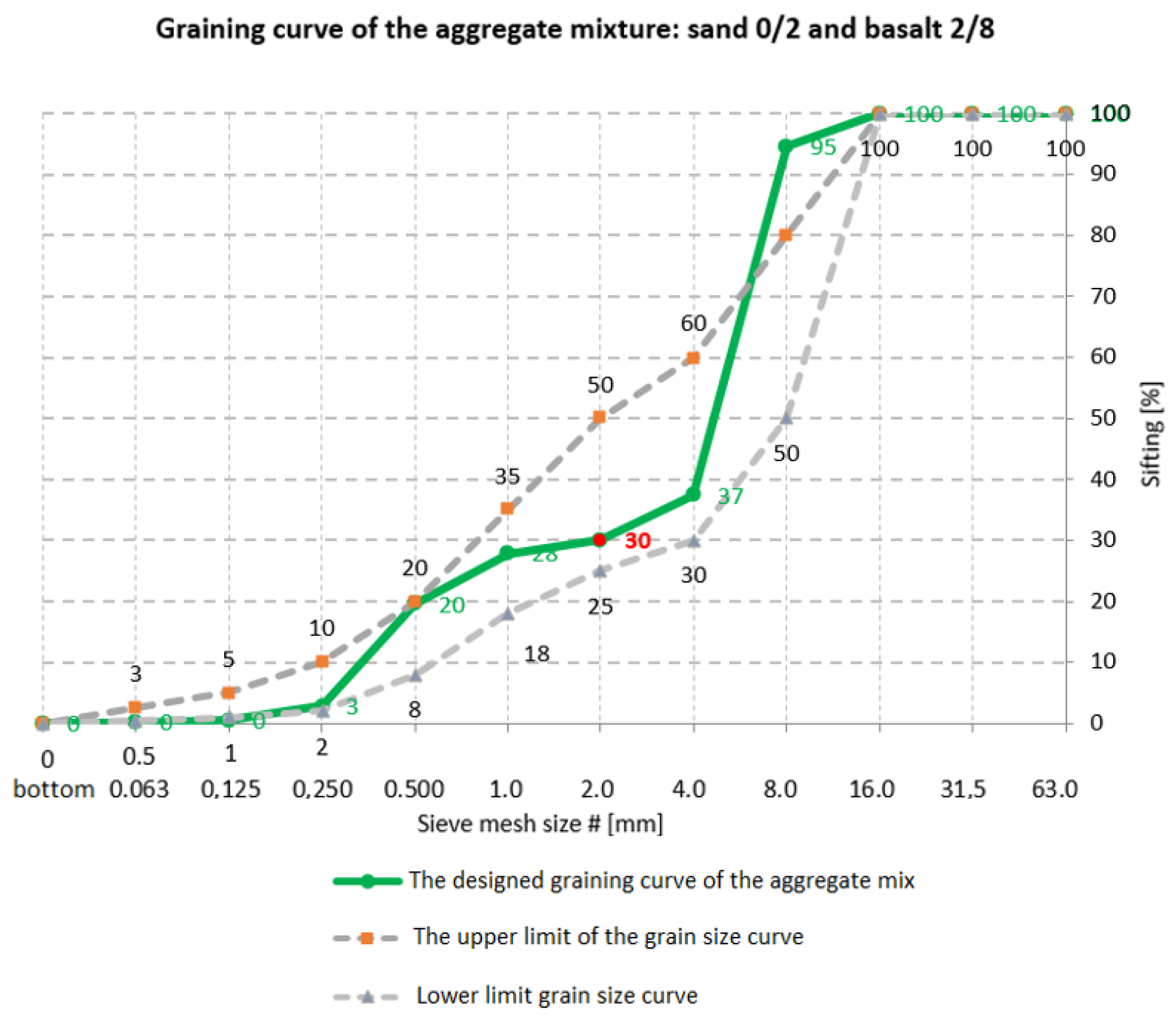
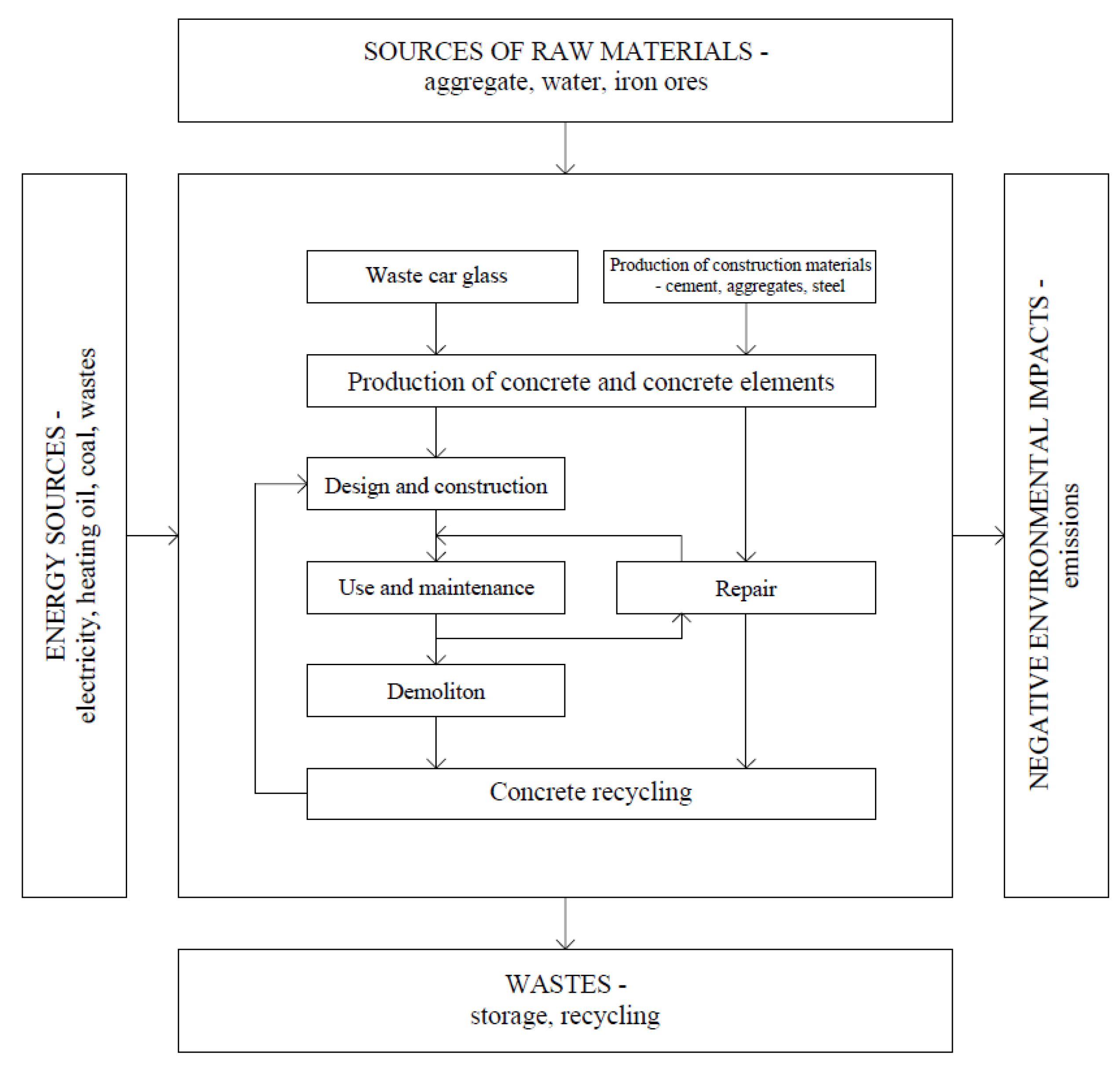
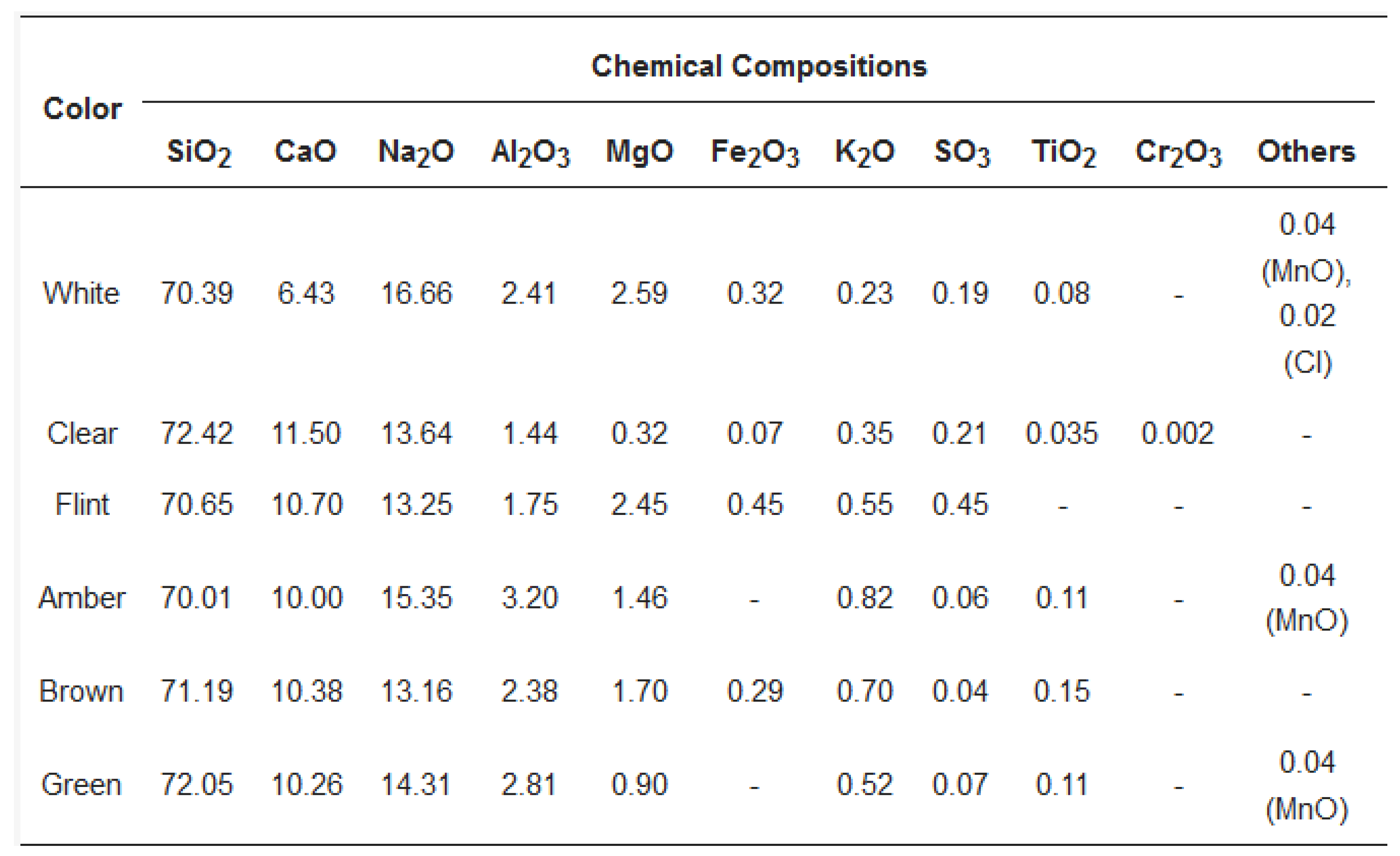

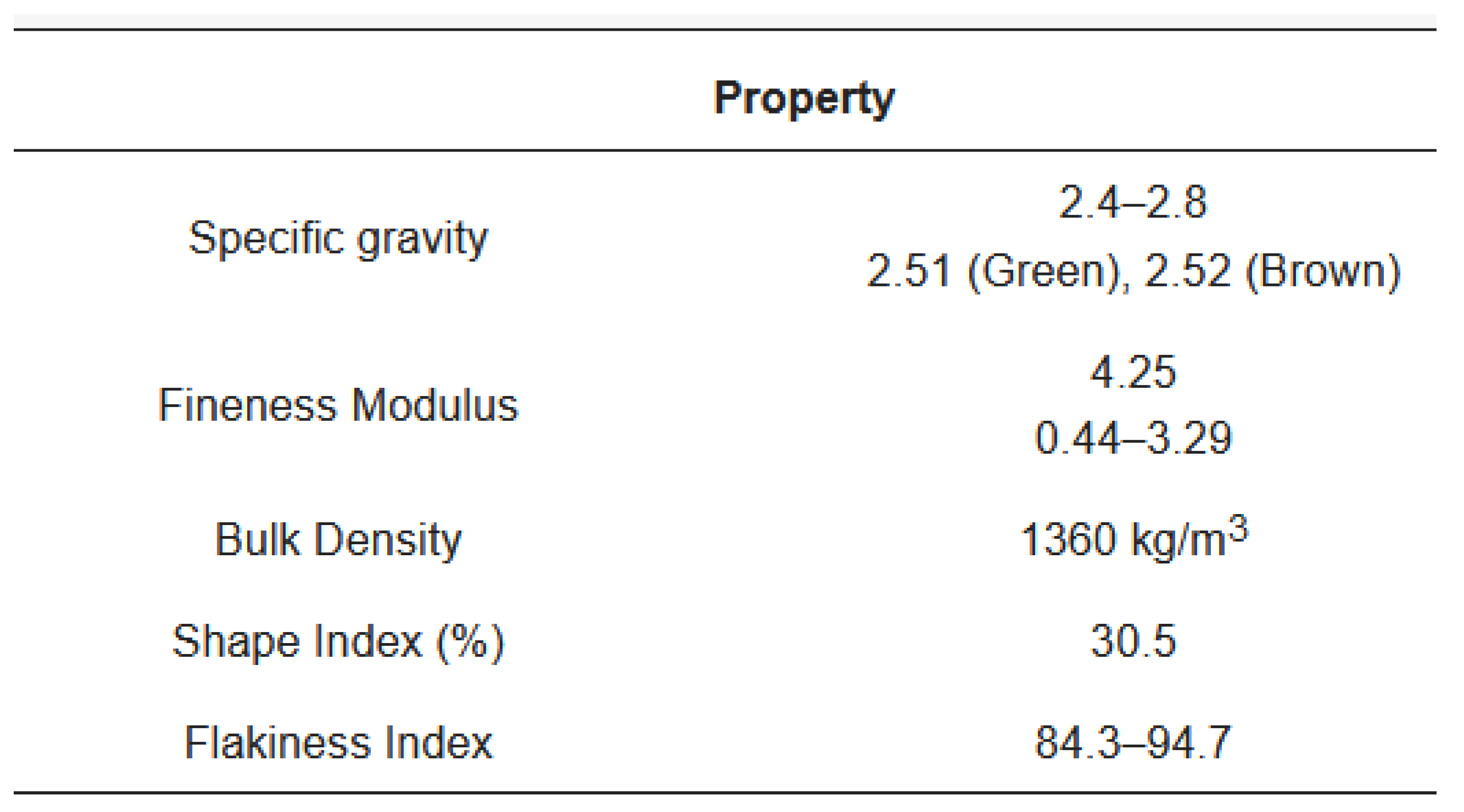
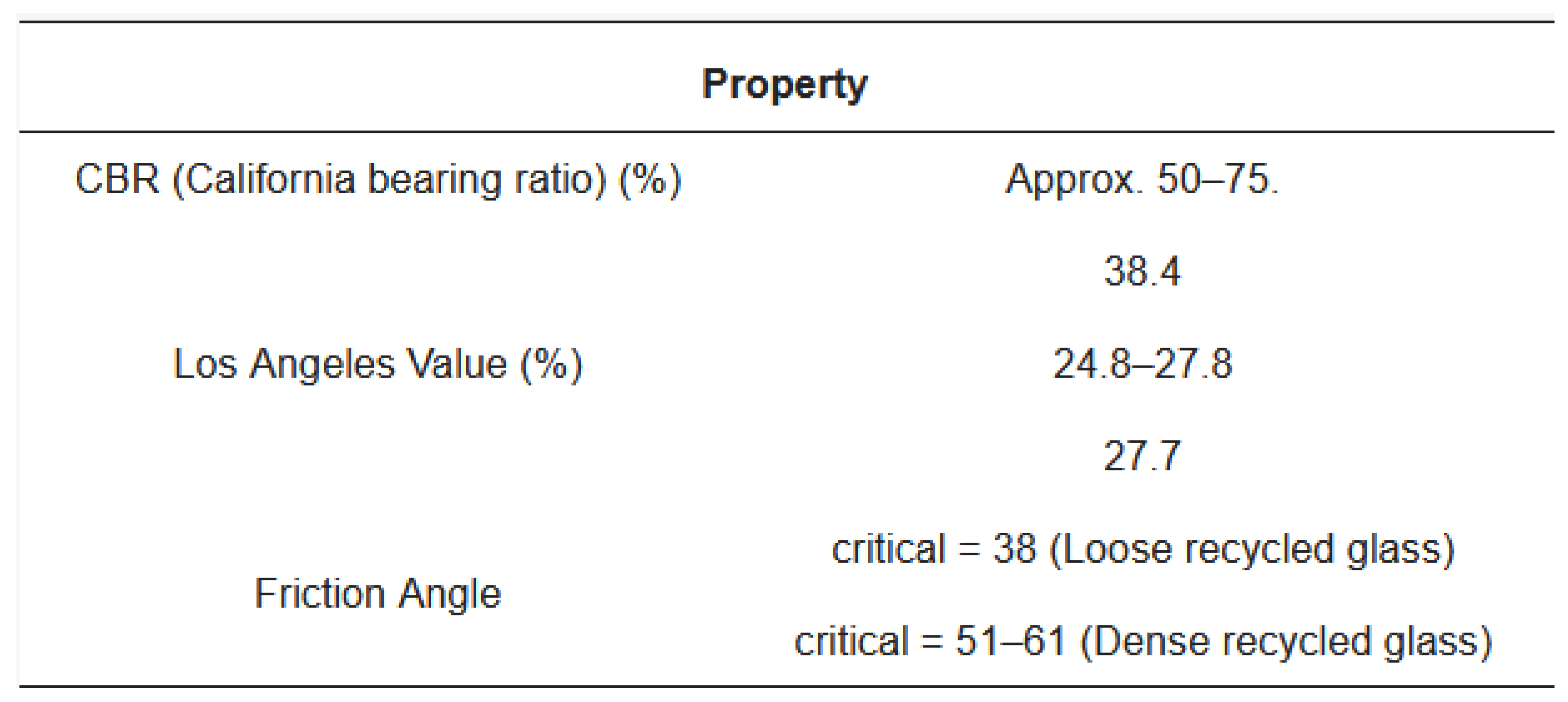
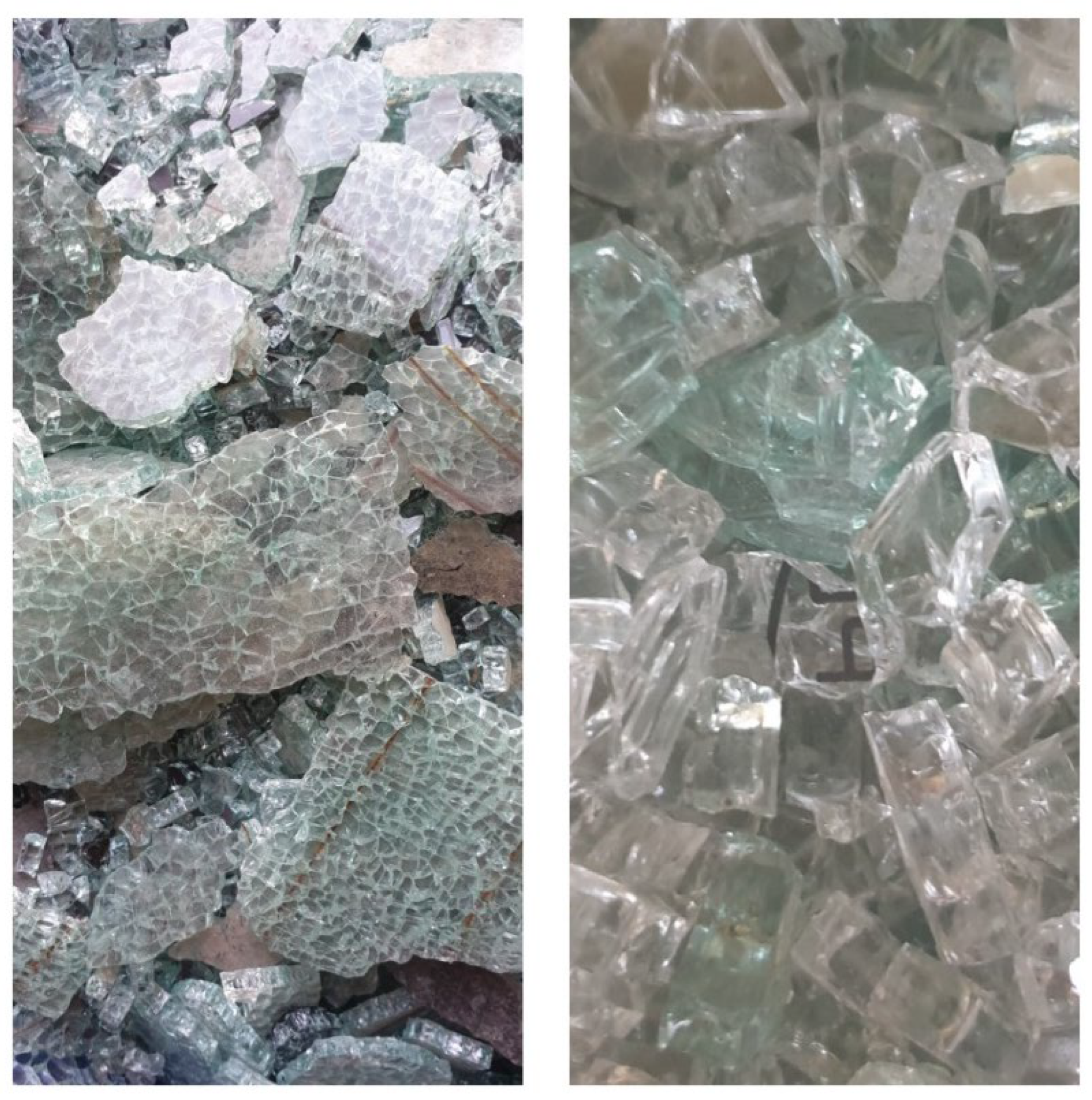
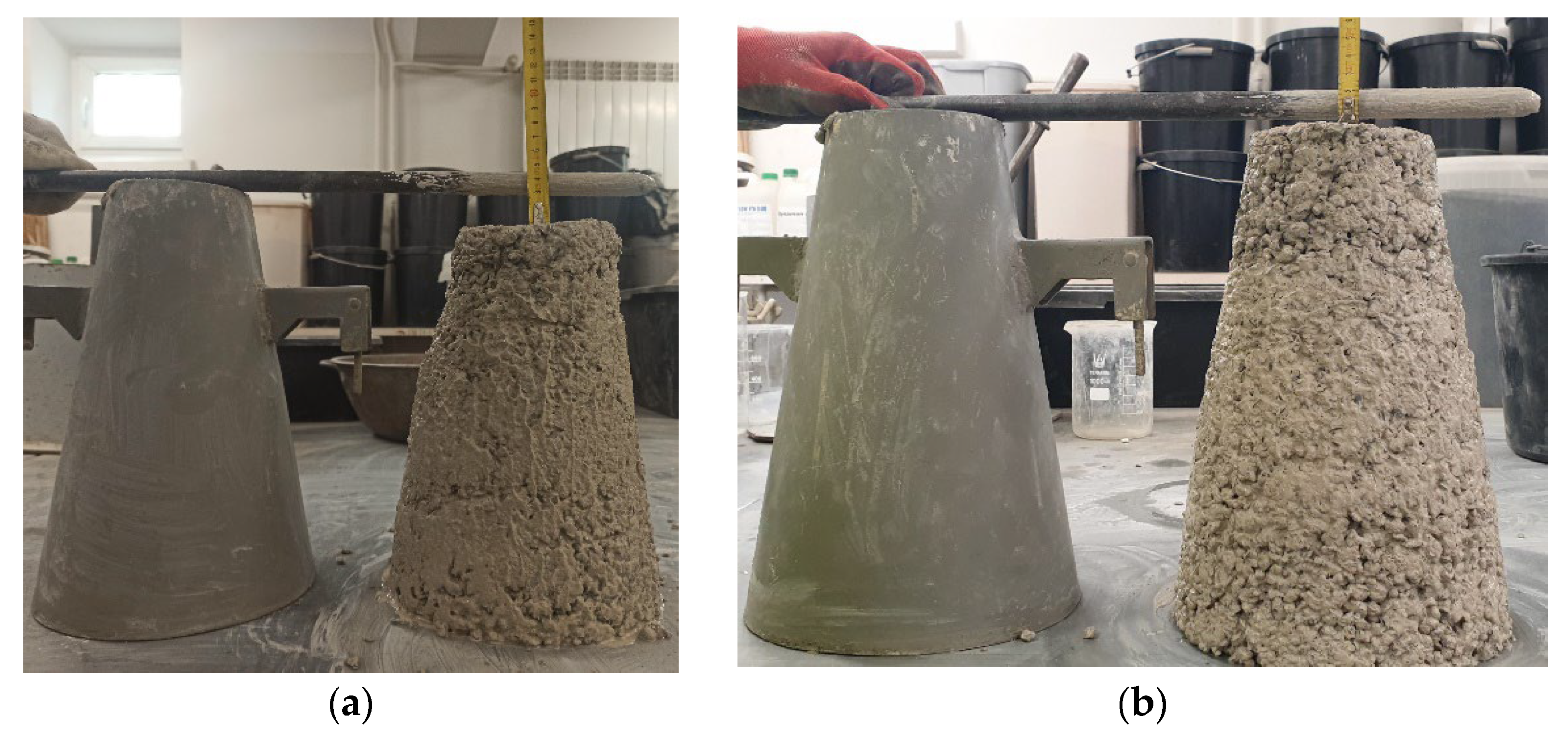

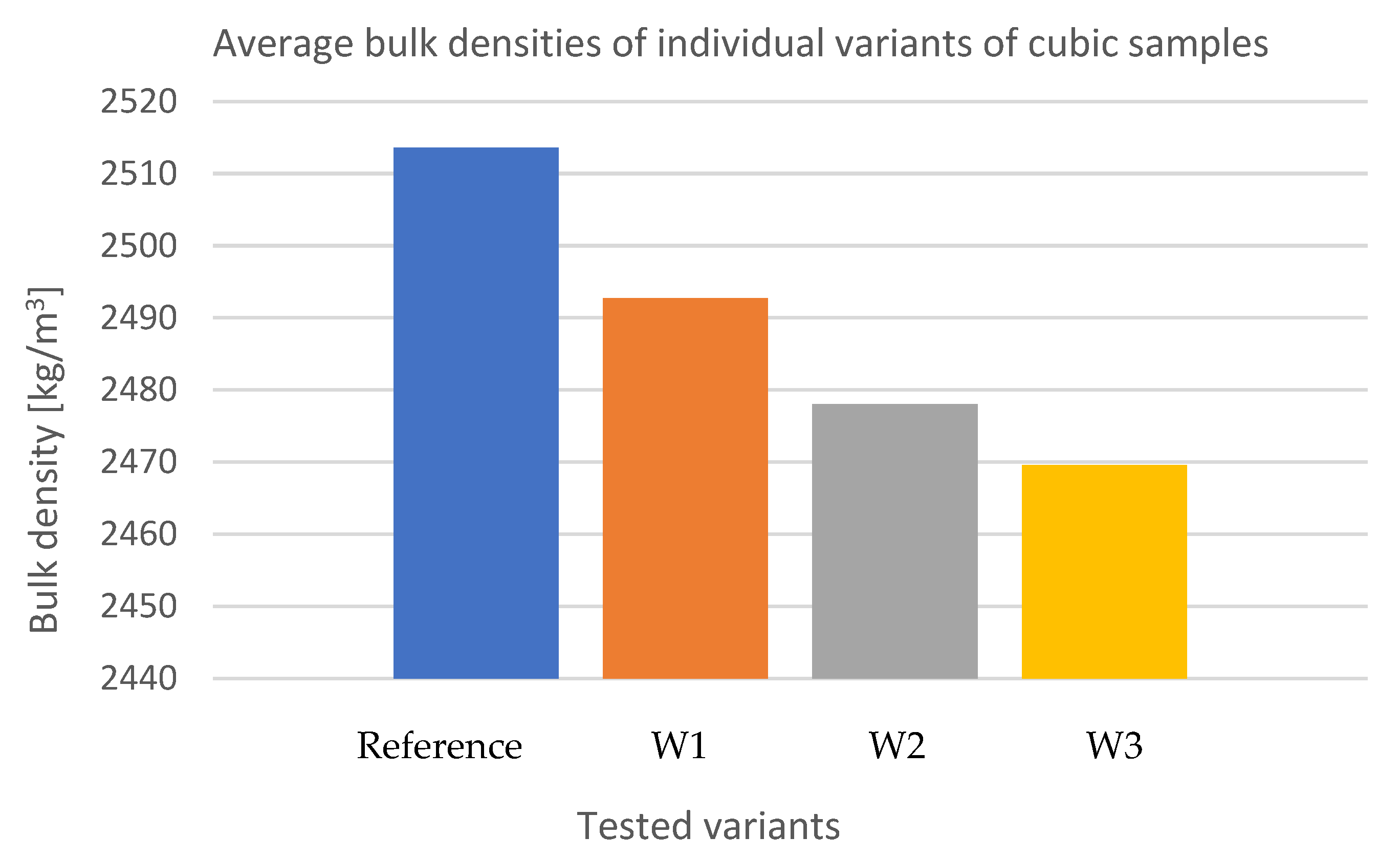

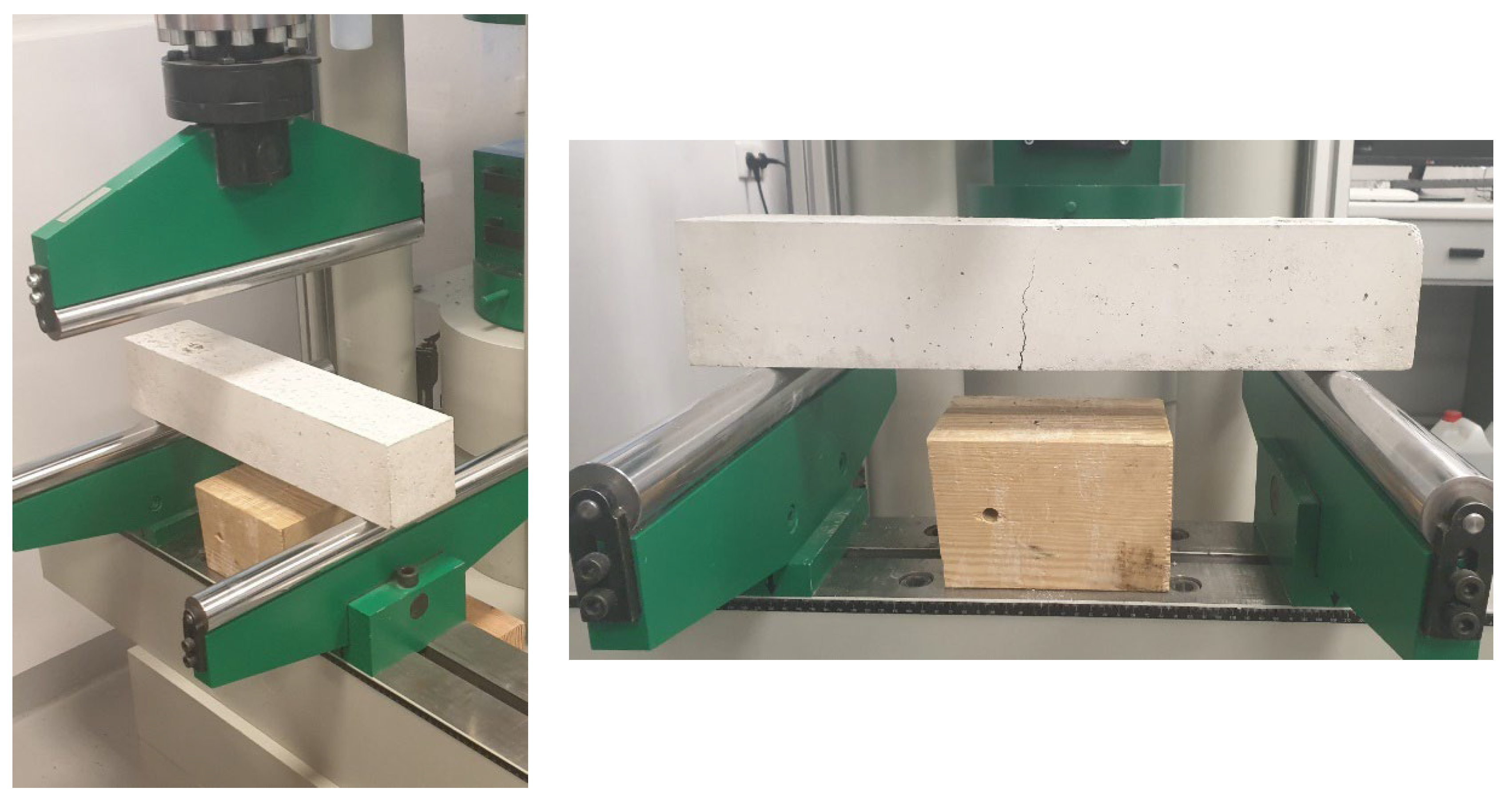
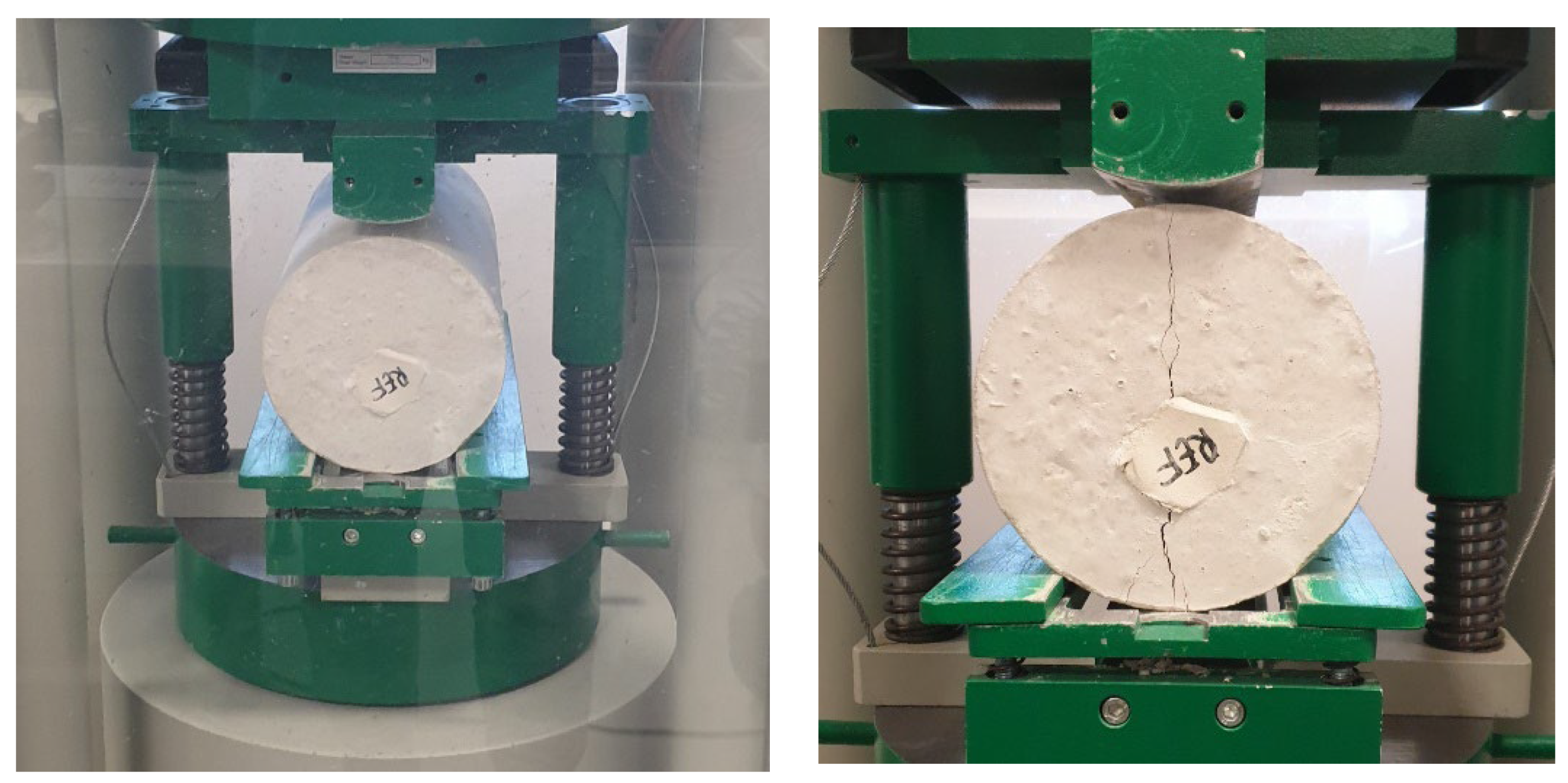
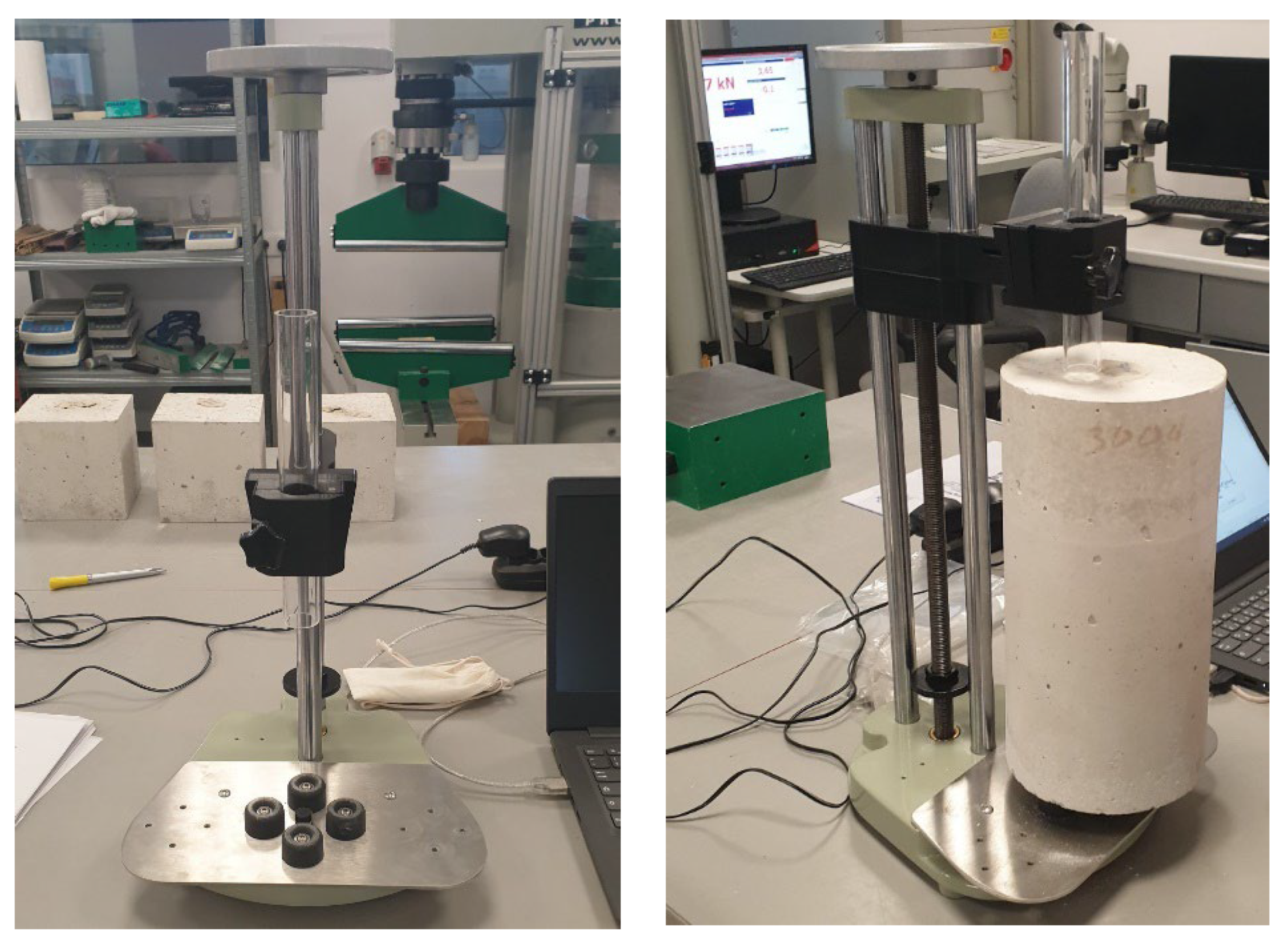

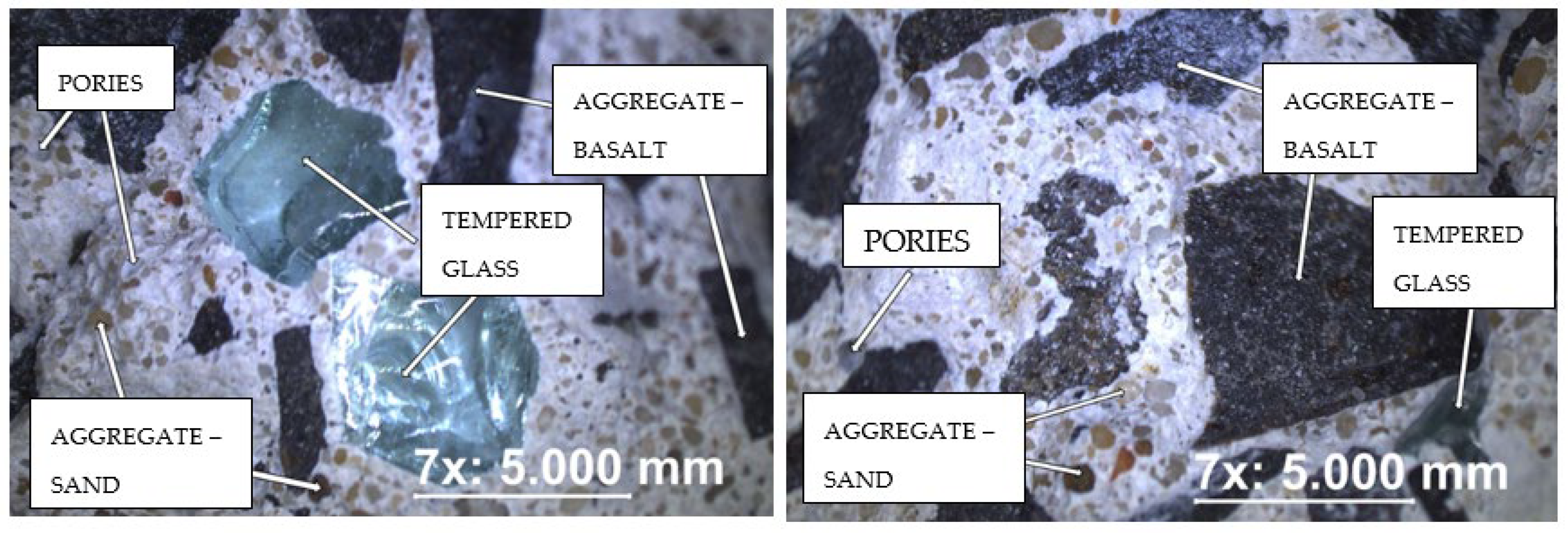
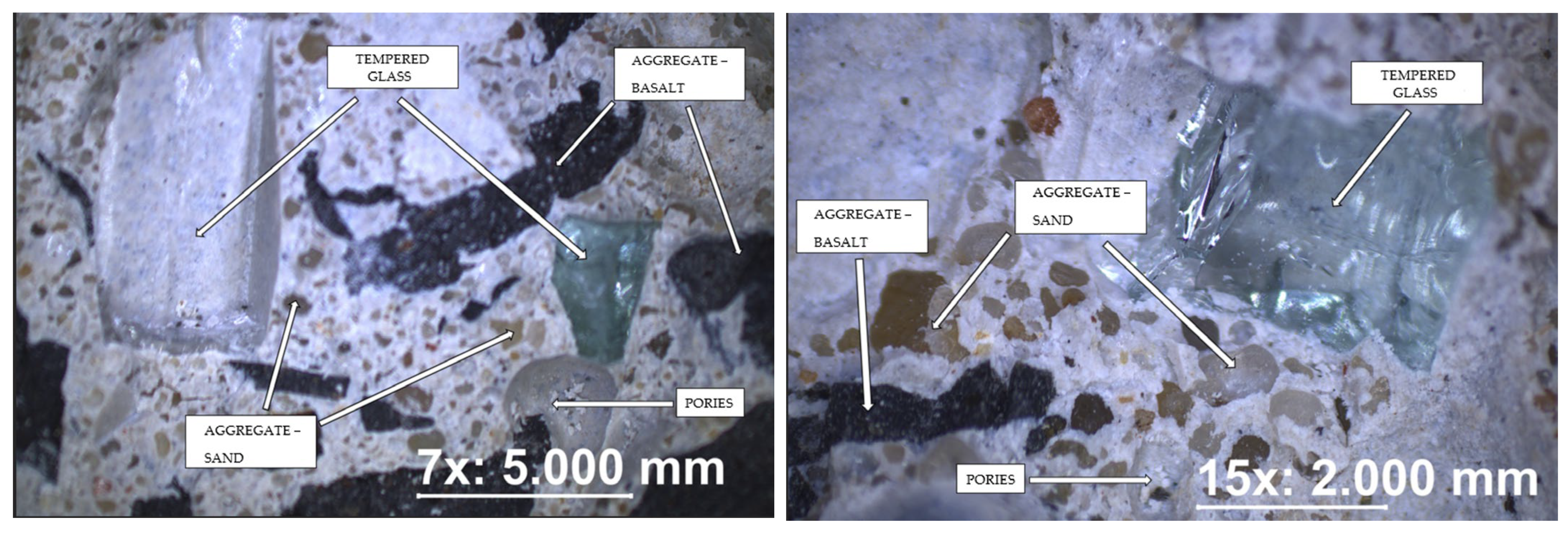
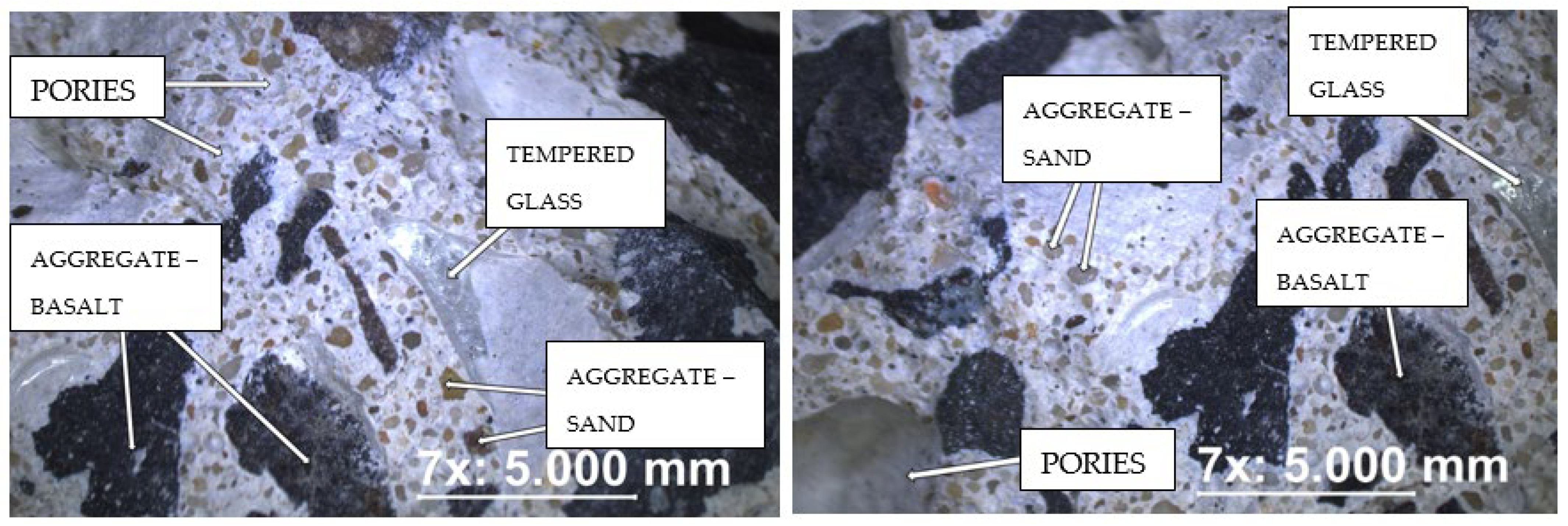
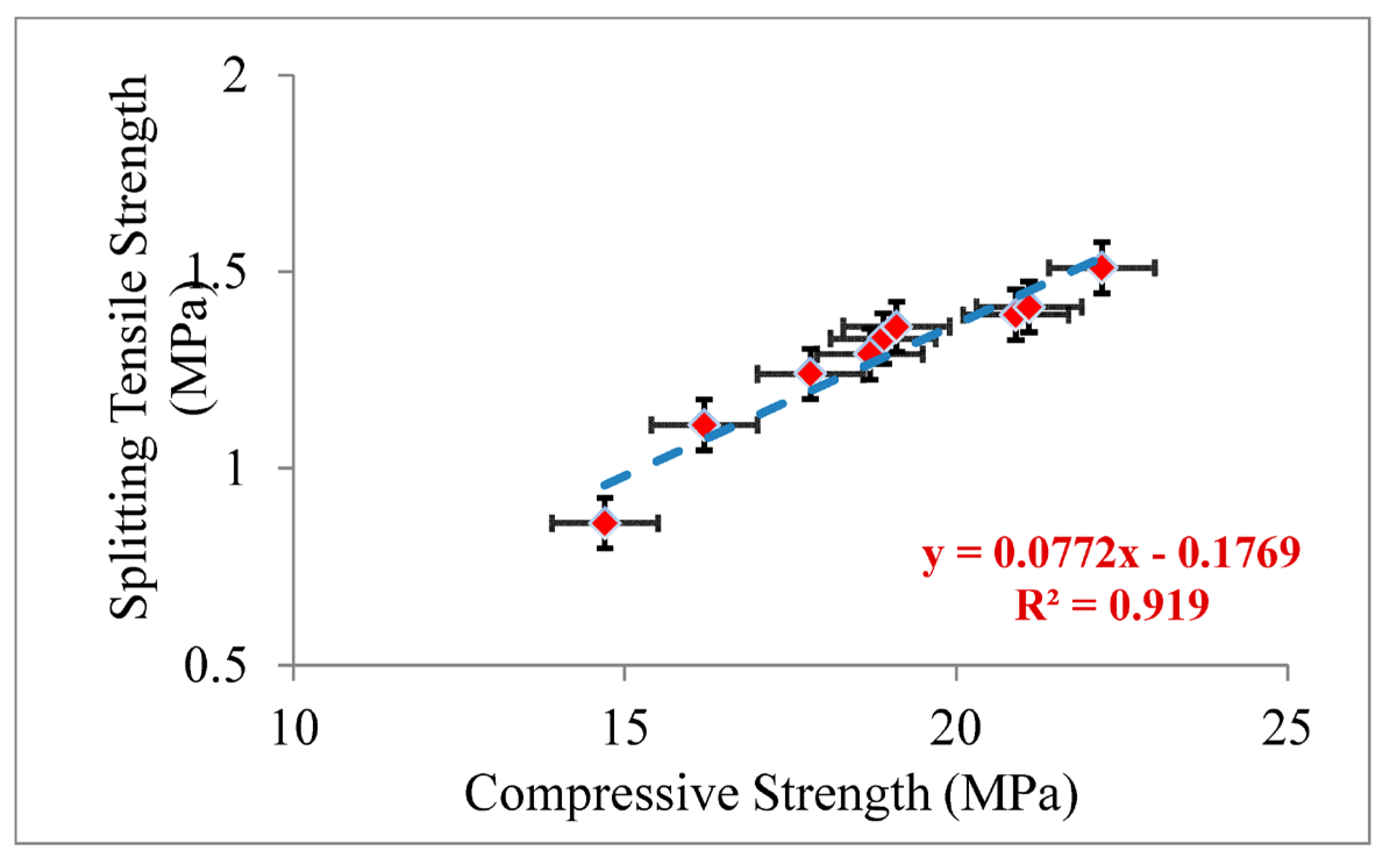
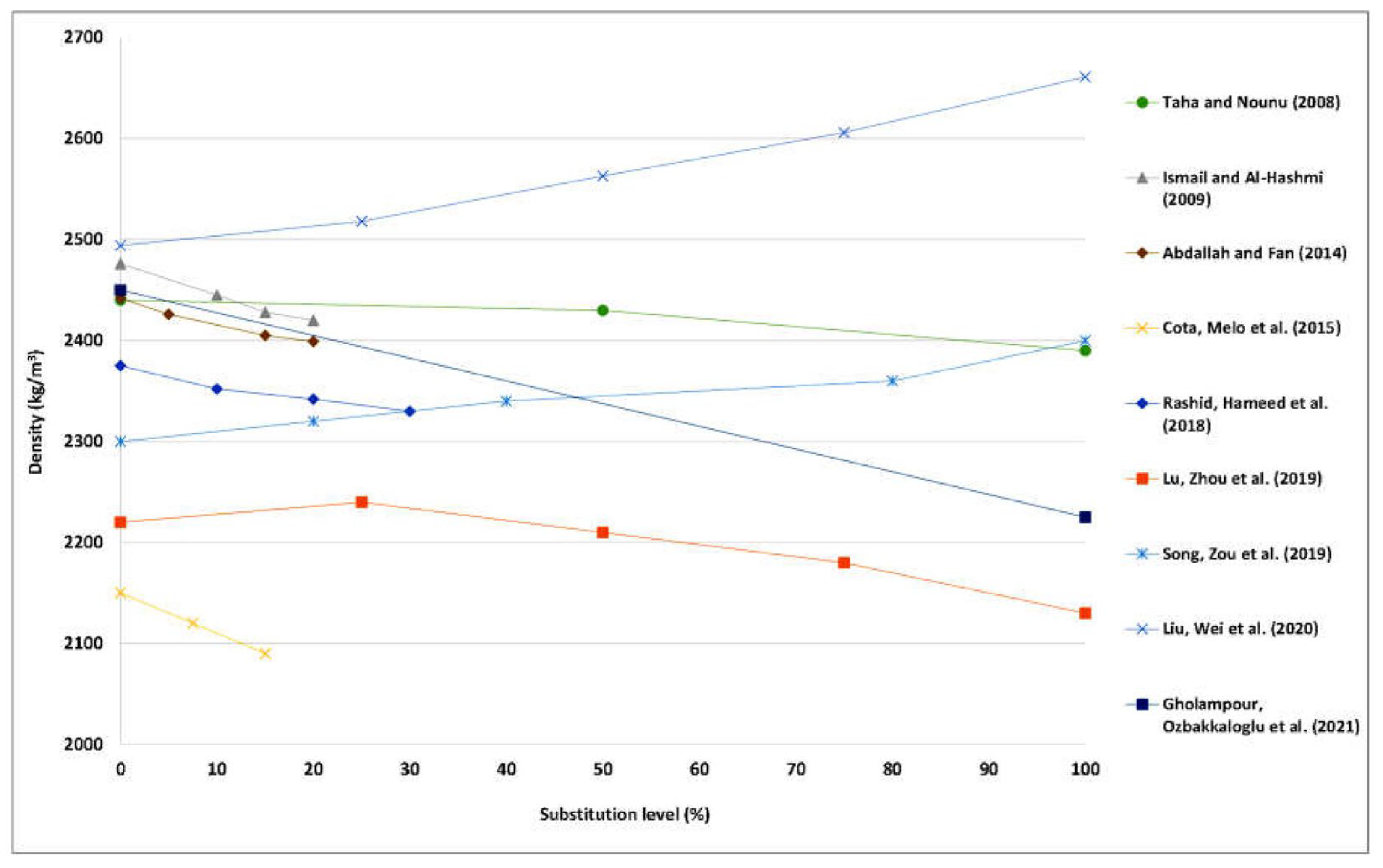
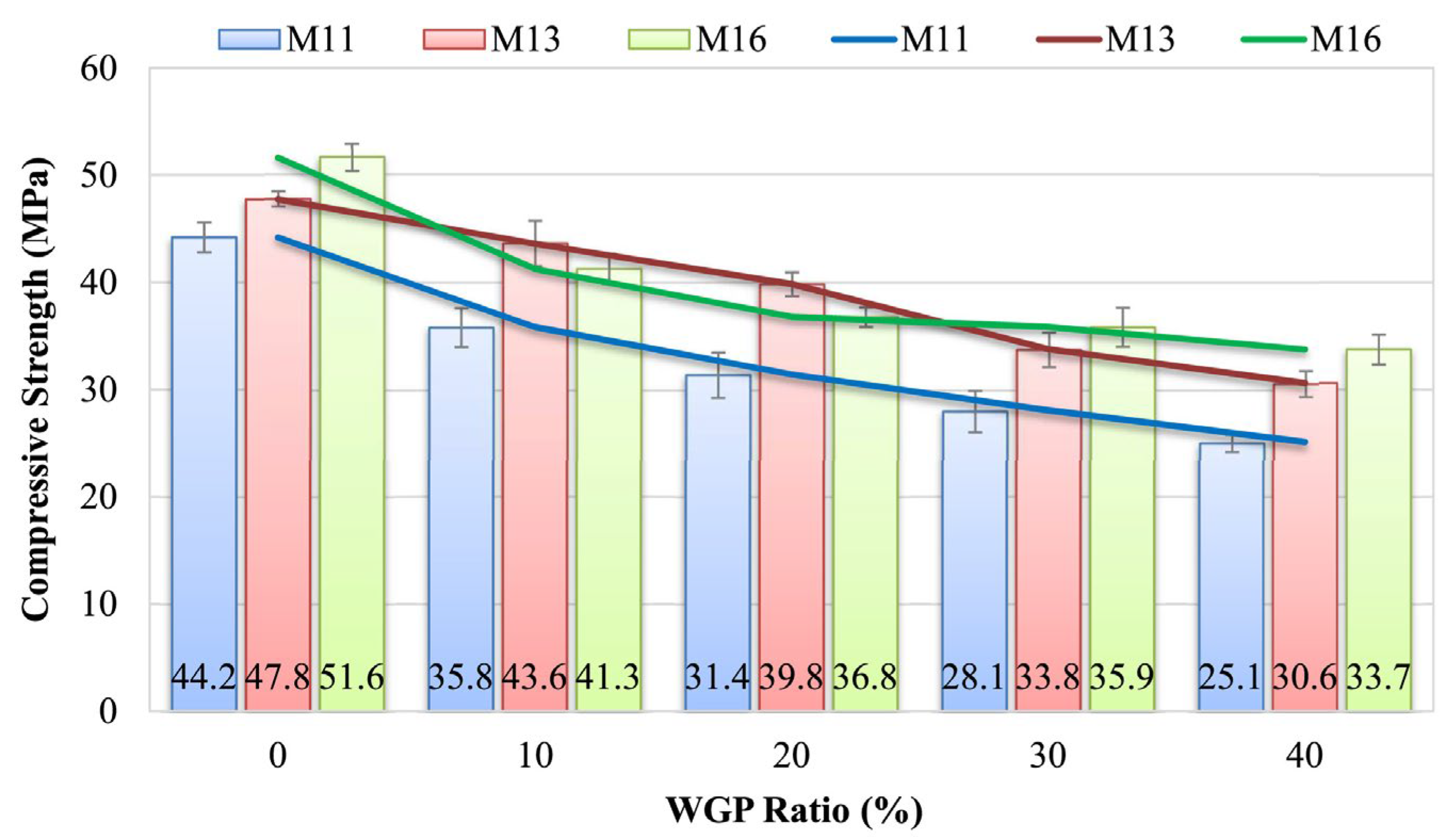

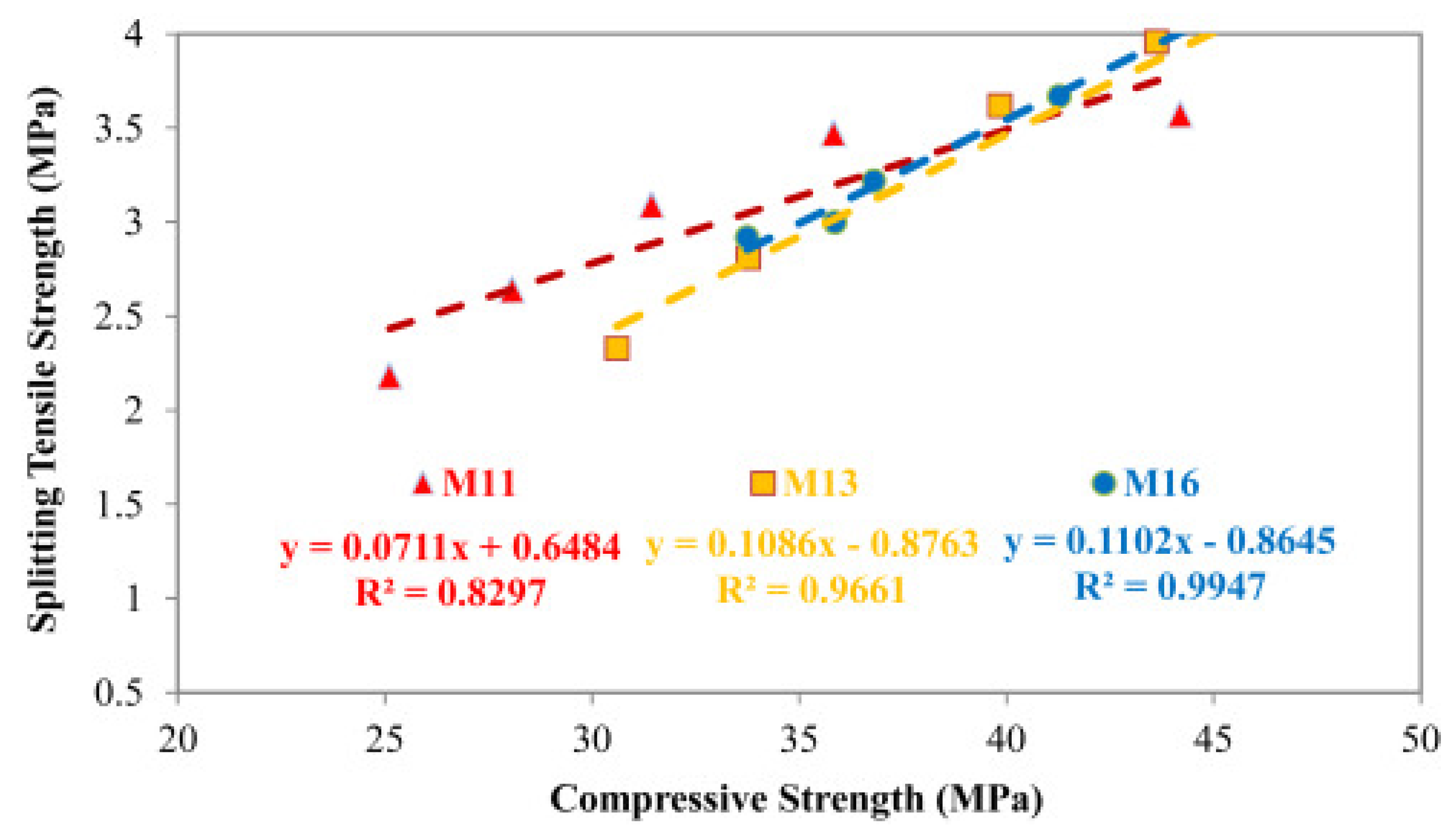
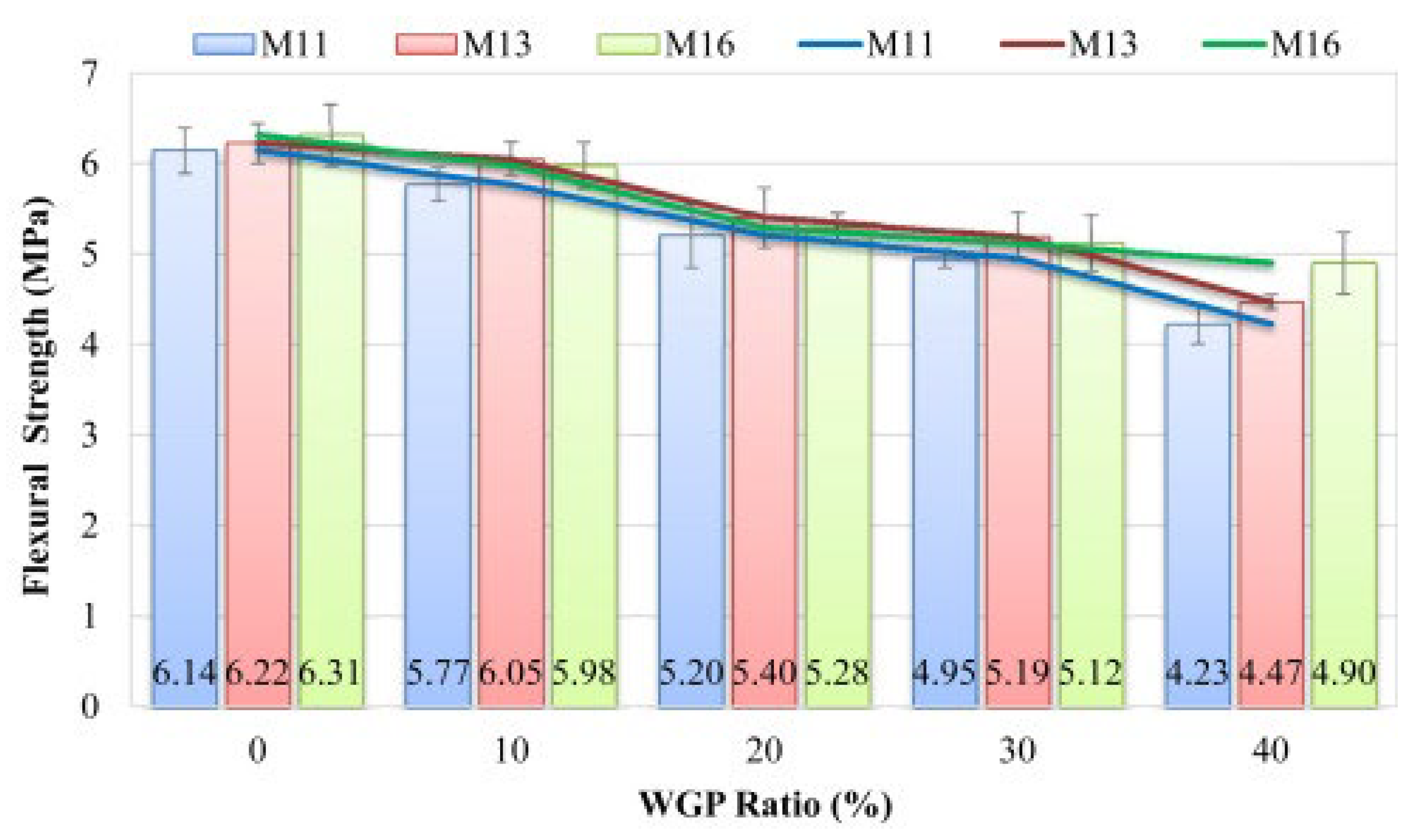
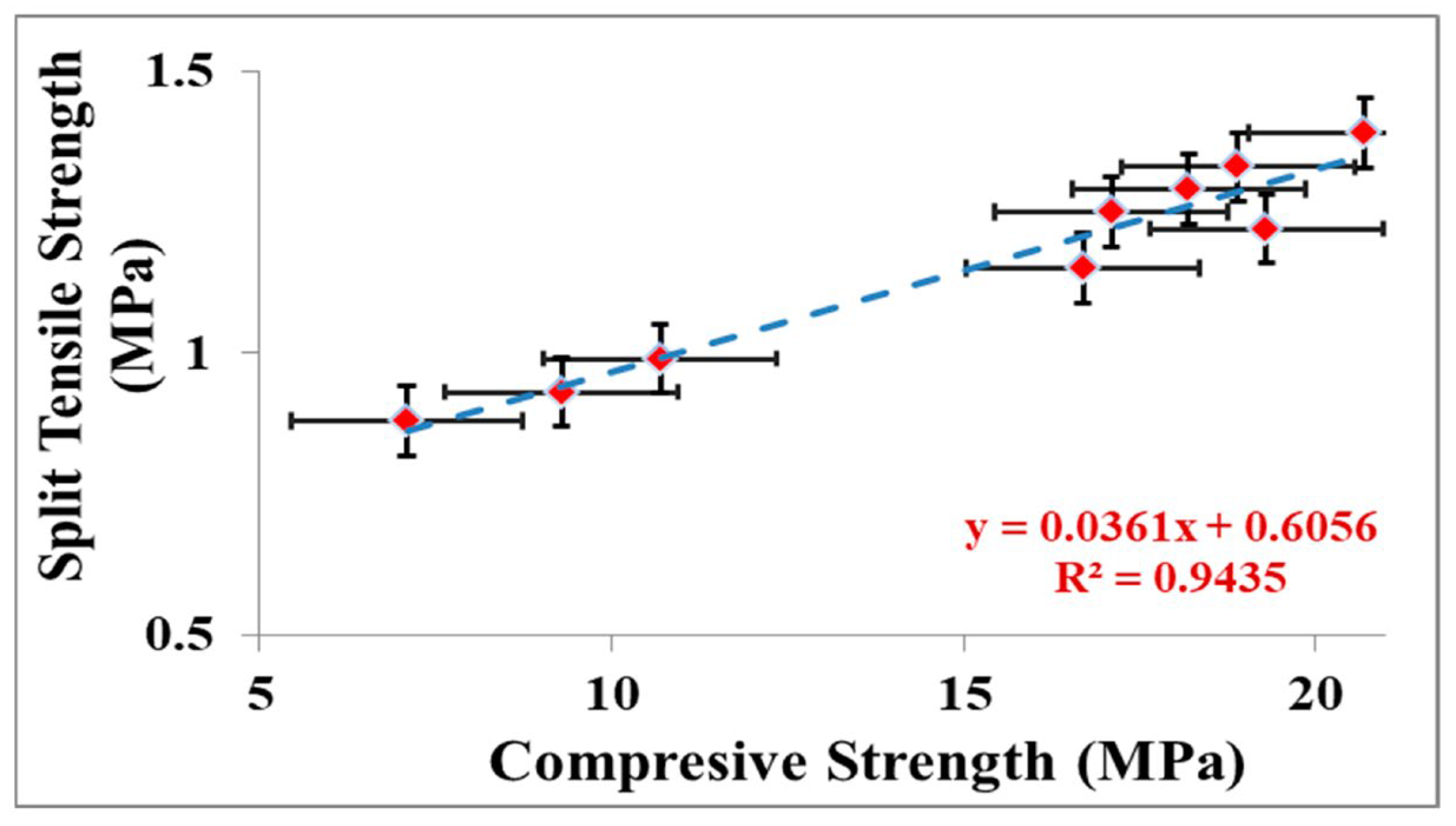
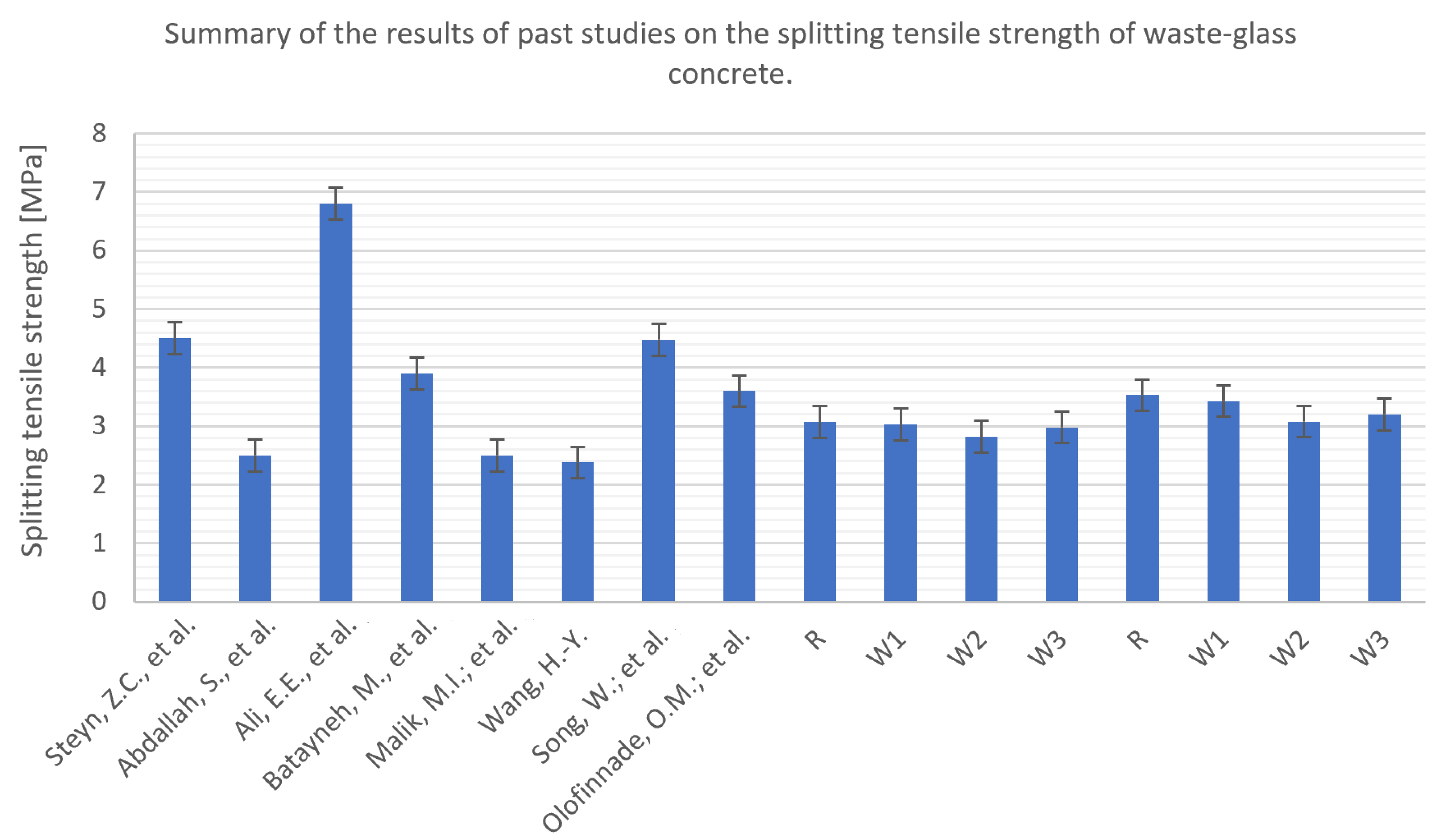
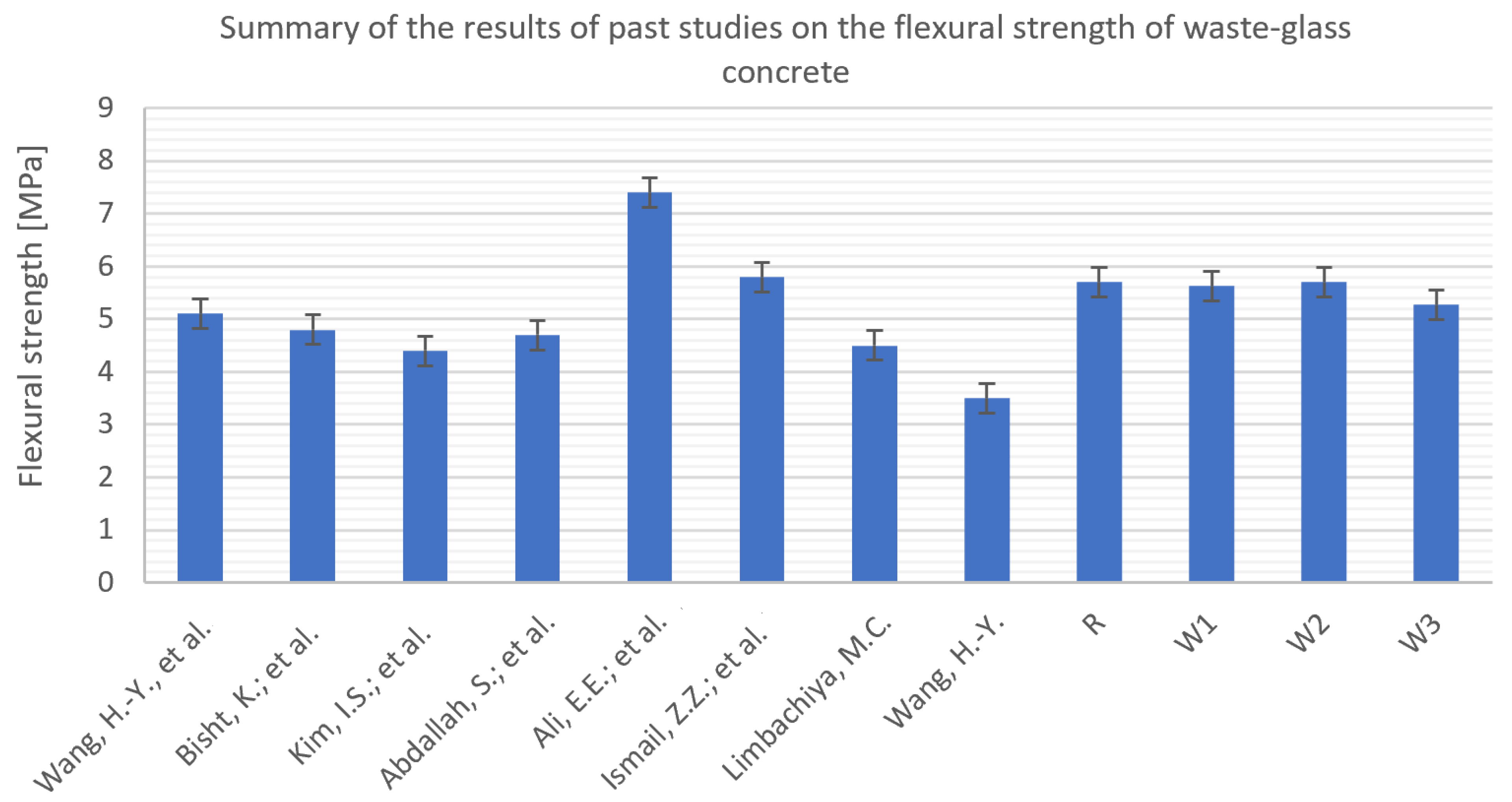
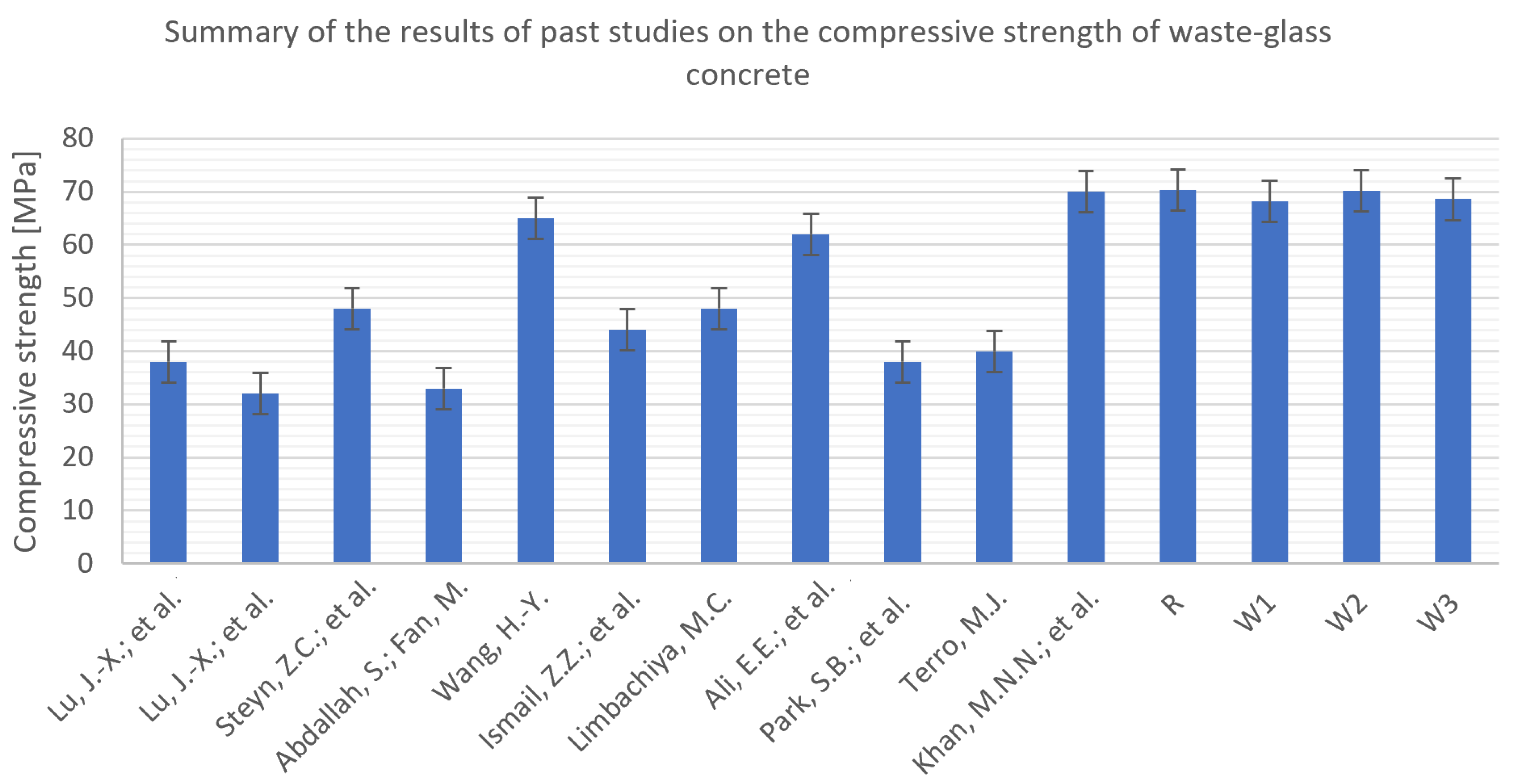
| Concrete Mix Recipe per m3 | ||||
|---|---|---|---|---|
| Aggregate (K1 + K2) | K = 1000/[(Wk/(1 – Wc × ω)) × (ω/ρc + 1) + (1/ρk)] = | 2048 | [kg/m3] | |
| Water | W = [Wk/(1 − Wc × ω)] × K = | 176 | [kg/m3] | |
| Cement | C = W × ω = | 367 | [kg/m3] | |
| Fine aggregate (K1)— Sand 0–2 | K1 = K × (K1/K) = | 599 | [kg/m3] | |
| Coarse aggregate (K2)—Basalt 2–8 | K2 = K × (K2/K) = | 1449 | [kg/m3] | |
| Bulk density of concrete mix—ρ | ρ = C + K1 + K2 + W = | 2591 | [kg/m3] | |
| Production phase | A1 | Extraction and production of raw materials |
| A2 | Transport | |
| A3 | Production of construction materials | |
| Construction phase | A4 | Transport |
| A5 | Construction | |
| Use phase | B1 | Use |
| B2 | Maintenance | |
| B3 | Repair | |
| B4 | Replacement | |
| B5 | Refurbishment | |
| B6 | Energy consuption | |
| B7 | Water consuption | |
| End-of-life phase | C1 | Demolition |
| C2 | Transport | |
| C3 | Waste processing | |
| C4 | Disposal |
| Design Point Load—Wheels [kN] | Design Point Load—Shelves [kN] | Concrete Class | Water/Cement Ratio | Concrete Slab Thickness [cm] | ||
|---|---|---|---|---|---|---|
| Daily Intensity | ||||||
| n ≤ 10 | n ≤ 50 | n ≤ 100 | ||||
| 10 | 15 | C25/30 | ≤0.55 | ≥16 | ≥16 | ≥18 |
| 20 | ≥16 | ≥18 | ≥20 | |||
| 30 | 25 | C30/37 | ≤0.50 | ≥16 | ≥18 | ≥20 |
| 40 | ≥18 | ≥20 | ≥22 | |||
| 60 | 35 | ≤0.45 | ≥20 | ≥22 | ≥24 | |
| 80 | ≥22 | ≥24 | ≥26 | |||
| 100 | 50 | C35/45 | ≥24 | ≥26 | ≥28 | |
| 120 | ≥26 | ≥28 | ≥30 | |||
| 140 | ≤0.42 | ≥28 | ≥30 | ≥32 | ||
| Component | Amount | Unit |
|---|---|---|
| Cement CEM I 52.5 R | 36,700 | kg |
| Fine aggregate—sand 0–2 | 59,900 | kg |
| Coarse aggregate—basalt 2–8 | 144,900 | kg |
| Water | 17,600 | kg |
| Car glass | 11,111 | kg |
| Parametr | Amount | Unit |
|---|---|---|
| Emissions to the environment | ||
| Global warming potential—CO2—eqv | 33,509 | kg |
| Depletion of natural resources | ||
| Fine aggregate—sand 0–2 | 64,692 | kg |
| Coarse aggregate—basalt 2–8 | 156,492 | kg |
| Water | 19,008 | kg |
| Limestone and aluminosilicates | 38,448 | kg |
| Gypsum | 1188 | kg |
| Depletion of energy sources | ||
| Fuel—Diesel | 2356 | L |
| Electricity—coal | 587 | kg |
| Thermal energy—coal | 3425 | kg |
| Thermal energy—RDF alternative fuel | 3171 | kg |
| Essential Characteristics | Usable Properties | Unit |
|---|---|---|
| Compressive strength | ||
| 1 day | 21–27 | MPa |
| 2 days | 40–48 | MPa |
| 7 days | 53–65 | MPa |
| 28 days | 66–76 | MPa |
| Initial setting time | 110–160 | min |
| Standard consistency | 30 | |
| Constant capacity | 0.5 | mm |
| Cement fineness (wg Blaine’a) | 400 | m2/kg |
| Specific mass (absolute density) | 3090–3190 | kg/m3 |
| Bulk-specific weight | 1080 | kg/m3 |
| Heat of hydration | 550 | kJ/kg |
| Chemical properties of clinker | ||
| C3S | 73 | % |
| C2S | 16 | % |
| C3A | 5 | % |
| C4AF | 1 | % |
| Chemical properties of cement | ||
| SO3 | 1.8–2.3 | % |
| MgO | 0.6 | % |
| Na2O | ≤0.3 | % |
| Chloride | ≤0.04 | % |
| roasting loss | 1 | % |
| Insoluble residue | 0.1 | % |
| Water-soluble Cr + 6 | ≤2 | mg/kg |
| Class | Cone Drop [mm] | Tolerance [mm] |
|---|---|---|
| S1 | 10–40 | ±10 |
| S2 | 50–90 | ±20 |
| S3 | 100–150 | ±30 |
| S4 | 160–210 | ±30 |
| S5 | ≥220 | ±30 |
| Variants | Cone Drop [mm] | Consistency Class |
|---|---|---|
| Reference | 30 | S1 |
| Variant 1 | 37 | S1 |
| Variant 2 | 7 | S1 |
| Variant 3 | 5 | S1 |
| Reference | W1 | W2 | W3 | |
|---|---|---|---|---|
| Density [kg/m3] | 2591 | 2658 | 2702 | 2747 |
| Consistence class | S1 | S1 | S1 | S1 |
| Air content [%] | 5.0 | 5.1 | 5.0 | 5.2 |
| Volume Densities of Cubic Samples [kg/m3] | ||||
|---|---|---|---|---|
| Reference | W1 | W2 | W3 | |
| 1 | 2483.7 | 2516.7 | 2548.1 | 2448.4 |
| 2 | 2548.0 | 2472.4 | 2504.3 | 2454.7 |
| 3 | 2518.1 | 2507.3 | 2463.6 | 2494.1 |
| 4 | 2503.3 | 2530.1 | 2459.7 | 2484.4 |
| 5 | 2498.7 | 2488.0 | 2476.1 | 2452.9 |
| 6 | 2529.8 | 2508.7 | 2421.3 | 2456.1 |
| 7 | - | 2425.9 | 2472.9 | 2496.4 |
| Average value | 2513.6 | 2492.7 | 2478.0 | 2469.6 |
| Variant | Destructive Force F [kN] | Compressive Strength [MPa] | Average Compressive Strength [MPa] | Standard Deviation | Confidence Interval [MPa] |
|---|---|---|---|---|---|
| Reference | 1533.6 | 68.2 | 70.30 | 1.836 | 64.71–75.89 |
| 1612.1 | 71.6 | ||||
| 1600.7 | 71.1 | ||||
| W1 | 1547.7 | 68.8 | 68.18 | 1.992 | 64.51–71.84 |
| 1591.7 | 70.7 | ||||
| 1505.1 | 66.9 | ||||
| 1492.2 | 66.3 | ||||
| W2 | 1560.2 | 69.3 | 70.13 | 1.905 | 66.62–73.63 |
| 1639.4 | 72.9 | ||||
| 1542.5 | 68.6 | ||||
| 1567.3 | 69.7 | ||||
| W3 | 1513 | 67.2 | 68.60 | 1.643 | 65.58–71.62 |
| 1549.7 | 68.9 | ||||
| 1518.4 | 67.5 | ||||
| 1592.1 | 70.8 |
| Variant | Destructive Force F [kN] | Flexural Tensile Strength [MPa] | Average Flexural Tensile Strength [MPa] | Standard Deviation | Confidence Interval [MPa] |
|---|---|---|---|---|---|
| Reference | 10.38 | 6.2 | 5.70 | 0.458 | 4.31–7.09 |
| 8.75 | 5.3 | ||||
| 9.32 | 5.6 | ||||
| W1 | 8.68 | 5.2 | 5.63 | 0.451 | 4.26–7.01 |
| 9.38 | 5.6 | ||||
| 10.22 | 6.1 | ||||
| W2 | 9.31 | 5.6 | 5.70 | 0.557 | 4.01–7.39 |
| 8.67 | 5.2 | ||||
| 10.28 | 6.3 | ||||
| W3 | 8.89 | 5.3 | 5.27 | 0.058 | 5.09–5.44 |
| 8.75 | 5.3 | ||||
| 8.65 | 5.2 |
| Variant | Destructive Force F [kN] | Tensile Strength When Splitting [MPa] | Average Tensile Strength When Splitting [MPa] | Standard Deviation | Confidence Interval [MPa] |
|---|---|---|---|---|---|
| Reference | 269.2 | 3.8 | 3.53 | 0.275 | 2.70–4.37 |
| 238.4 | 3.25 | ||||
| 254.2 | 3.55 | ||||
| W1 | 221.1 | 3.15 | 3.43 | 0.275 | 2.60–4.27 |
| 243.0 | 3.45 | ||||
| 262.4 | 3.7 | ||||
| W2 | 218.2 | 3.1 | 3.08 | 0.625 | 1.18–4.99 |
| 260.0 | 3.7 | ||||
| 171.9 | 2.45 | ||||
| W3 | 232.5 | 3.3 | 3.20 | 0.100 | 2.90–3.50 |
| 212.8 | 3.1 | ||||
| 226.3 | 3.2 |
| Variant | Modulus of Elasticity [GPa] | The Average Value of the Modulus of Elasticity [GPa] | Standard Deviation |
|---|---|---|---|
| Reference | 46.7 | 47.6 | 0.902 |
| 48.5 | |||
| 47.7 | |||
| W1 | 46.9 | 46.8 | 0.058 |
| 46.8 | |||
| 46.8 | |||
| W2 | 46.9 | 46.9 | 0.551 |
| 46.4 | |||
| 47.5 | |||
| W3 | 46.5 | 46.4 | 0.153 |
| 46.2 | |||
| 46.4 |
| Variant | Modulus of Elasticity [GPa] | The Average Value of the Modulus of Elasticity [GPa] | Standard Deviation |
|---|---|---|---|
| Referencja | 40.1 | 41.2 | 1.102 |
| 42.3 | |||
| 41.3 | |||
| W1 | 40.4 | 40.3 | 0.100 |
| 40.3 | |||
| 40.2 | |||
| W2 | 40.3 | 40.4 | 0.702 |
| 39.7 | |||
| 41.1 | |||
| W3 | 39.8 | 39.7 | 0.100 |
| 39.6 | |||
| 39.7 |
| Reference | W1 | W2 | W3 | |
|---|---|---|---|---|
| Mass [g] | 8483.3 | 8413.0 | 8363.3 | 8334.9 |
| Bulk density [kg/m3] | 2513.6 | 2492.7 | 2478.0 | 2469.6 |
| Compressive strength [MPa] | 70.30 | 68.18 | 70.13 | 68.60 |
| Flexural strength [MPa] | 5.70 | 5.63 | 5.70 | 5.27 |
| Splitting tensile strength— cubic specimens [MPa] | 3.07 | 3.03 | 2.82 | 2.98 |
| Splitting tensile strength— cylindrical specimens [MPa] | 3.53 | 3.43 | 3.08 | 3.20 |
| Dynamic Young’s modulus [GPa] | 47.6 | 46.8 | 46.9 | 46.4 |
| Static Young’s modulus [GPa] | 41.2 | 40.3 | 40.4 | 39.7 |
| No | Variant | The Value of the Thermal Conductivity Coefficient—λ | Unit |
|---|---|---|---|
| 1 | Reference | 1.8837 | [W/m·K] |
| 2 | W1 | 1.9086 | |
| 3 | W2 | 1.8496 | |
| 4 | W3 | 1.7336 |
| No | Variant | The Value of the Thermal Conductivity Coefficient—λ | Unit |
|---|---|---|---|
| 1 | Reference | 1.9184 | [W/m·K] |
| 2 | W1 | 1.9202 | |
| 3 | W2 | 1.9025 | |
| 4 | W3 | 1.8699 |
| No | Variant | The Right Warmth—cp | Size Multiplier | Unit |
|---|---|---|---|---|
| 1 | Reference | 1.7646 | ×106 | [J/m3·K] |
| 2 | W1 | 1.7049 | ||
| 3 | W2 | 1.7483 | ||
| 4 | W3 | 1.8276 |
| No | Variant | The Right Warmth—cp | Size Multiplier | Unit |
|---|---|---|---|---|
| 1 | Reference | 1.5591 | ×106 | [J/m3·K] |
| 2 | W1 | 1.5911 | ||
| 3 | W2 | 1.7329 | ||
| 4 | W3 | 1.7673 |
| No | Variant | Thermal Diffusivity—a | Size Multiplier | Unit |
|---|---|---|---|---|
| 1 | Reference | 1.0675 | ×10−6 | [m2/s] |
| 2 | W1 | 1.1195 | ||
| 3 | W2 | 1.0579 | ||
| 4 | W3 | 0.9486 |
| No | Variant | Thermal Diffusivity—a | Size Multiplier | Unit |
|---|---|---|---|---|
| 1 | Reference | 1.2305 | ×10−6 | [m2/s] |
| 2 | W1 | 1.2068 | ||
| 3 | W2 | 1.0979 | ||
| 4 | W3 | 1.0581 |
| Reference | W1 | W2 | W3 | |
| Bulk density [kg/m3] | 2513.6 | 2492.7 | 2478.0 | 2469.6 |
| Reference | W1 | W2 | W3 | |
|---|---|---|---|---|
| Compressive strength [MPa] | 70.30 | 68.18 | 70.13 | 68.60 |
| Reference | W1 | W2 | W3 | |
|---|---|---|---|---|
| Splitting tensile strength— cubic specimens [MPa] | 3.07 | 3.03 | 2.82 | 2.98 |
| Splitting tensile strength— cylindrical specimens [MPa] | 3.53 | 3.43 | 3.08 | 3.20 |
| Reference | W1 | W2 | W3 | |
|---|---|---|---|---|
| Flexural strength [MPa] | 5.70 | 5.63 | 5.70 | 5.27 |
Disclaimer/Publisher’s Note: The statements, opinions and data contained in all publications are solely those of the individual author(s) and contributor(s) and not of MDPI and/or the editor(s). MDPI and/or the editor(s) disclaim responsibility for any injury to people or property resulting from any ideas, methods, instructions or products referred to in the content. |
© 2023 by the authors. Licensee MDPI, Basel, Switzerland. This article is an open access article distributed under the terms and conditions of the Creative Commons Attribution (CC BY) license (https://creativecommons.org/licenses/by/4.0/).
Share and Cite
Starczyk-Kołbyk, A.; Małek, M. Analysis of the Life Cycle and Properties of Concrete with the Addition of Waste Car Glass. Sustainability 2023, 15, 10836. https://doi.org/10.3390/su151410836
Starczyk-Kołbyk A, Małek M. Analysis of the Life Cycle and Properties of Concrete with the Addition of Waste Car Glass. Sustainability. 2023; 15(14):10836. https://doi.org/10.3390/su151410836
Chicago/Turabian StyleStarczyk-Kołbyk, Anna, and Marcin Małek. 2023. "Analysis of the Life Cycle and Properties of Concrete with the Addition of Waste Car Glass" Sustainability 15, no. 14: 10836. https://doi.org/10.3390/su151410836
APA StyleStarczyk-Kołbyk, A., & Małek, M. (2023). Analysis of the Life Cycle and Properties of Concrete with the Addition of Waste Car Glass. Sustainability, 15(14), 10836. https://doi.org/10.3390/su151410836







